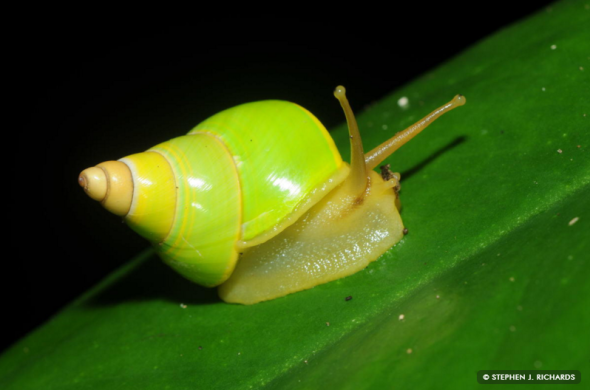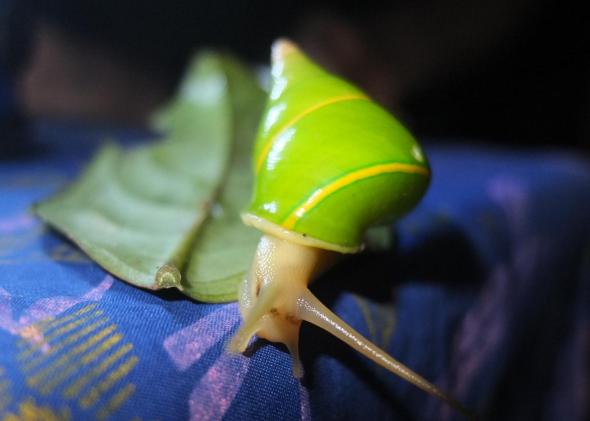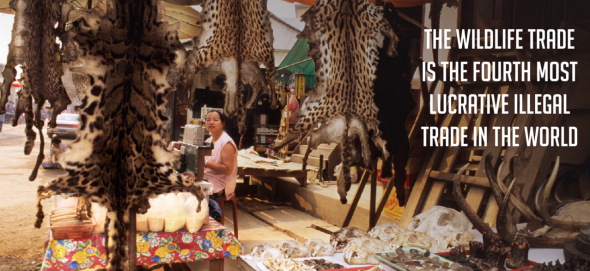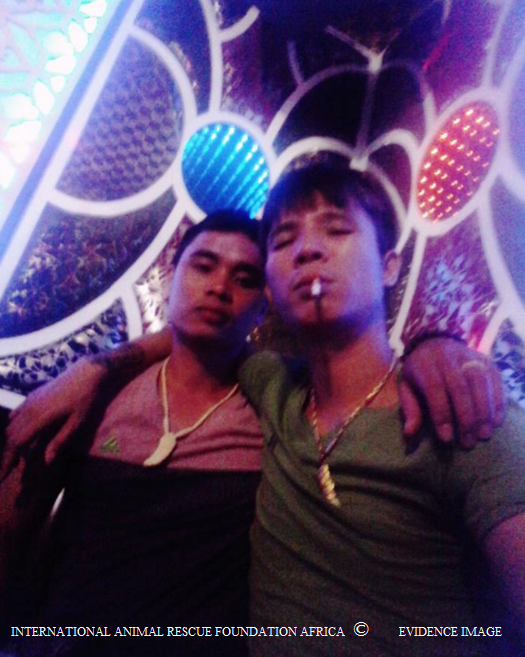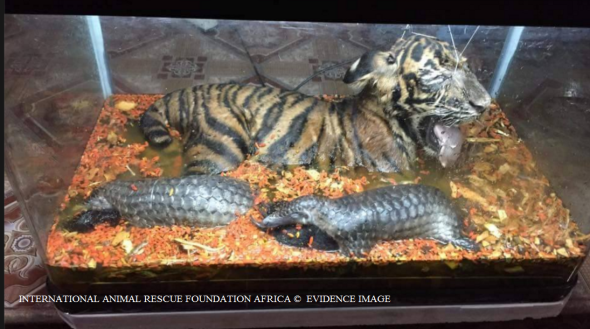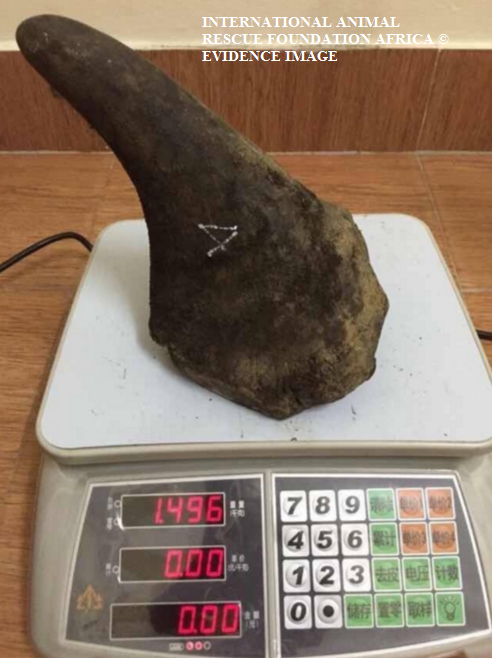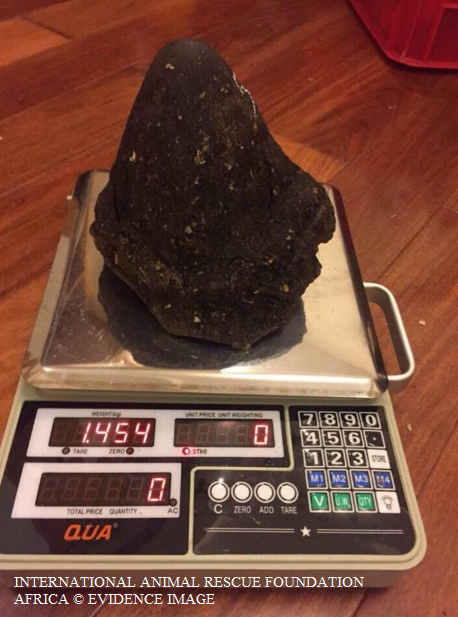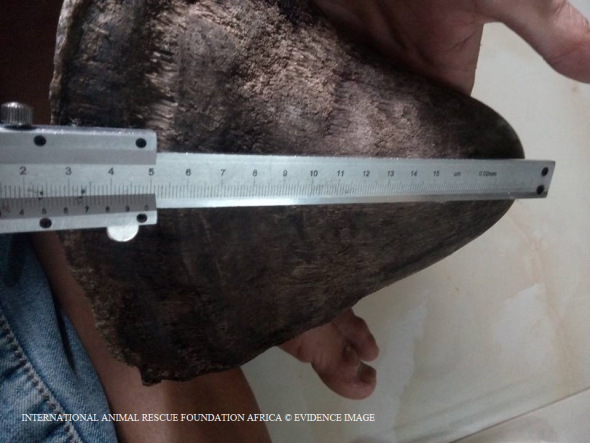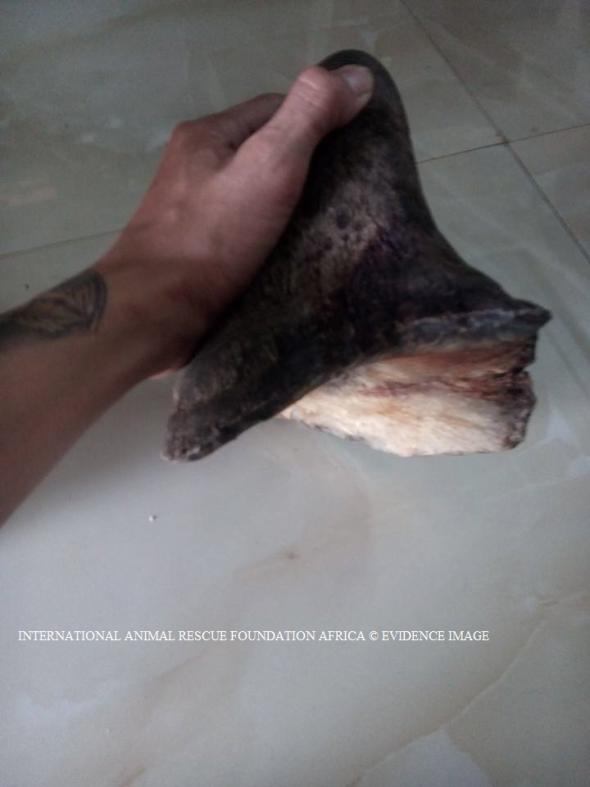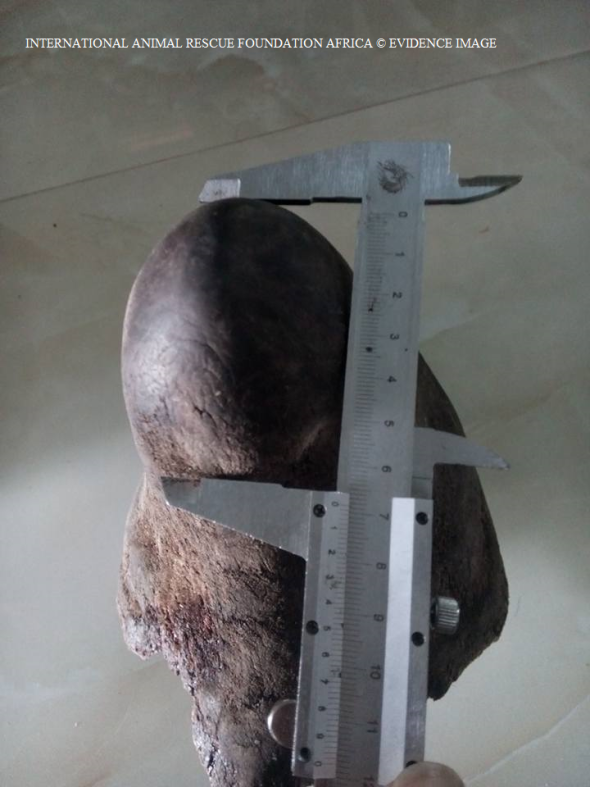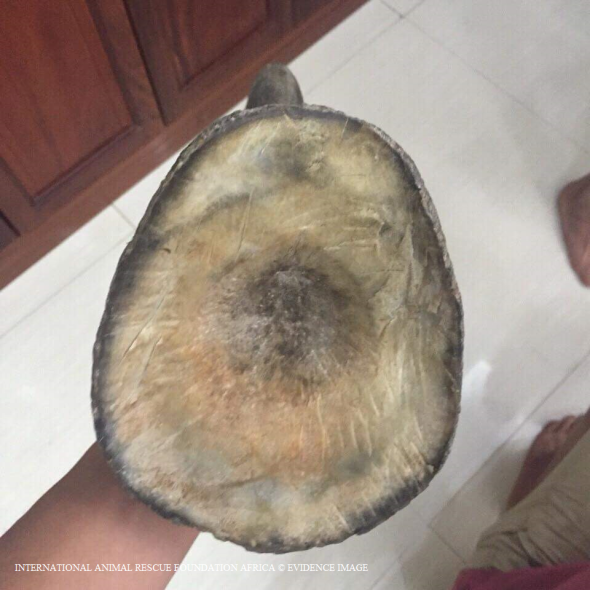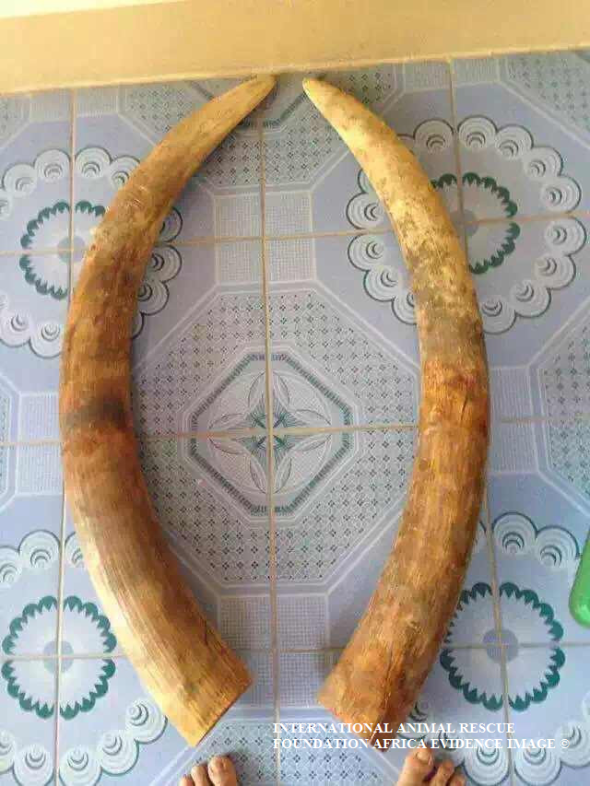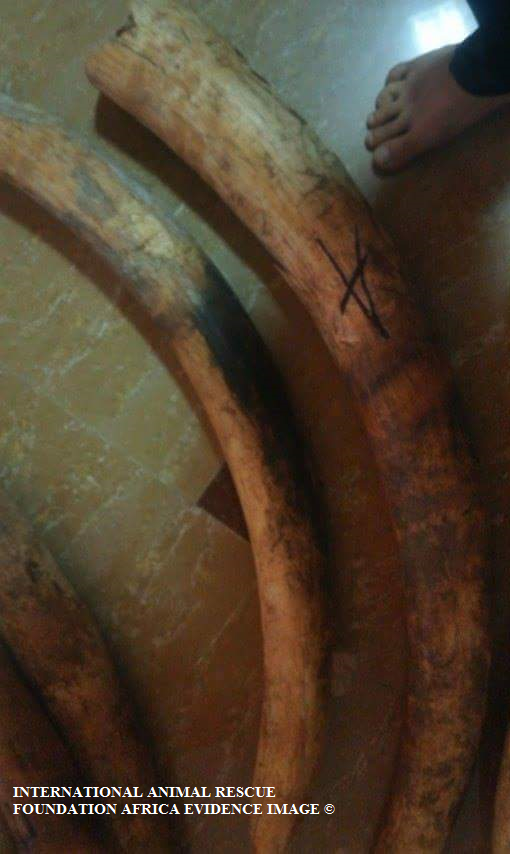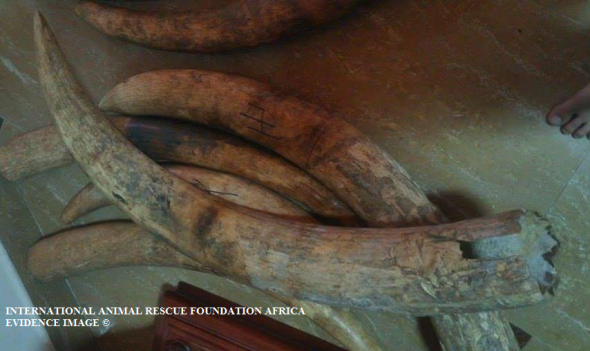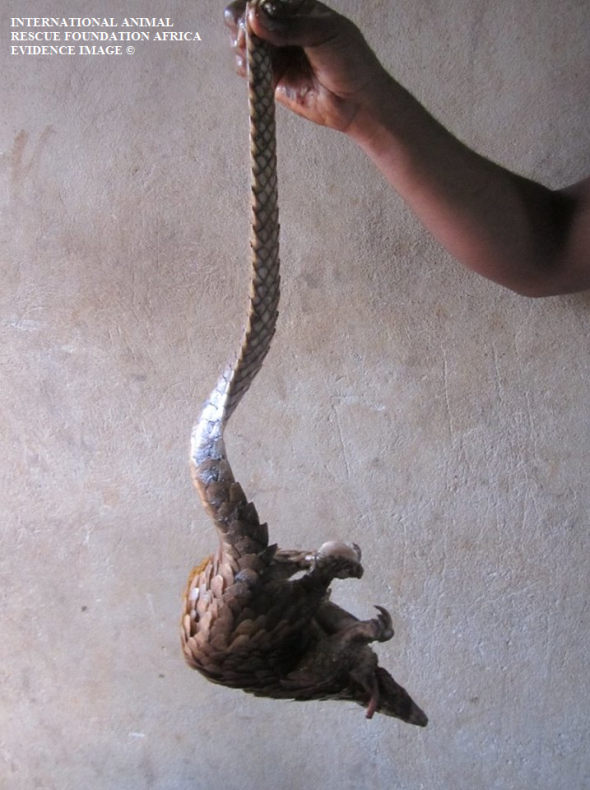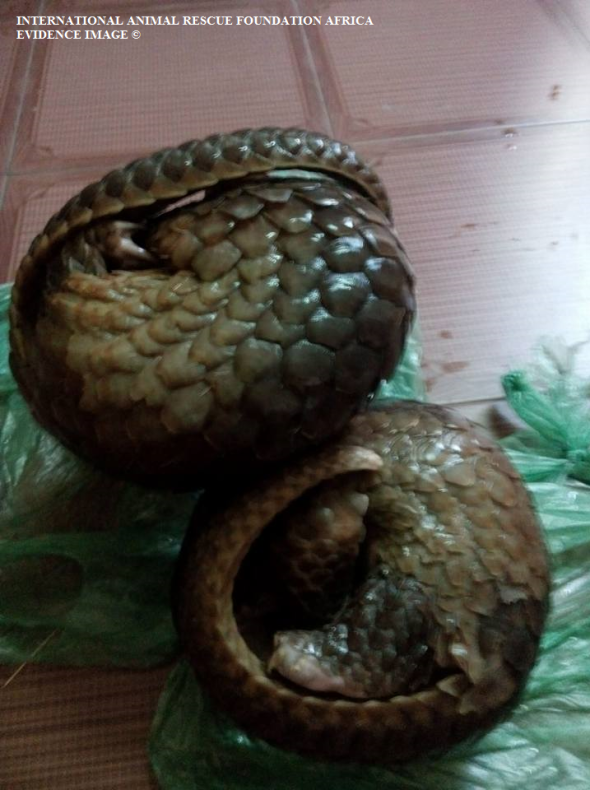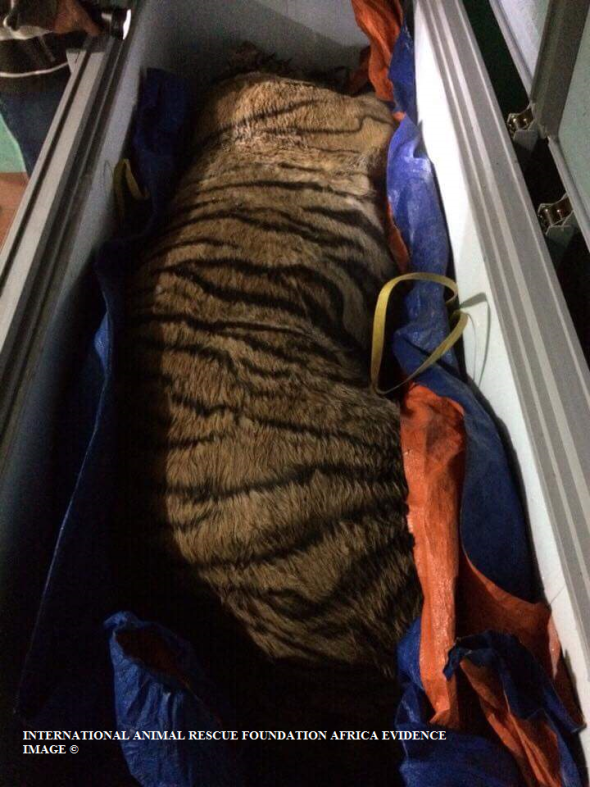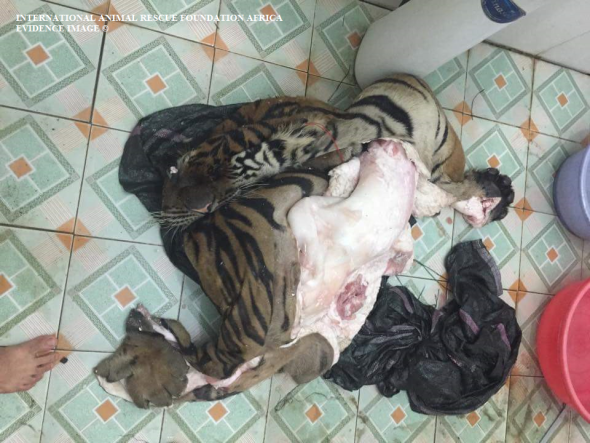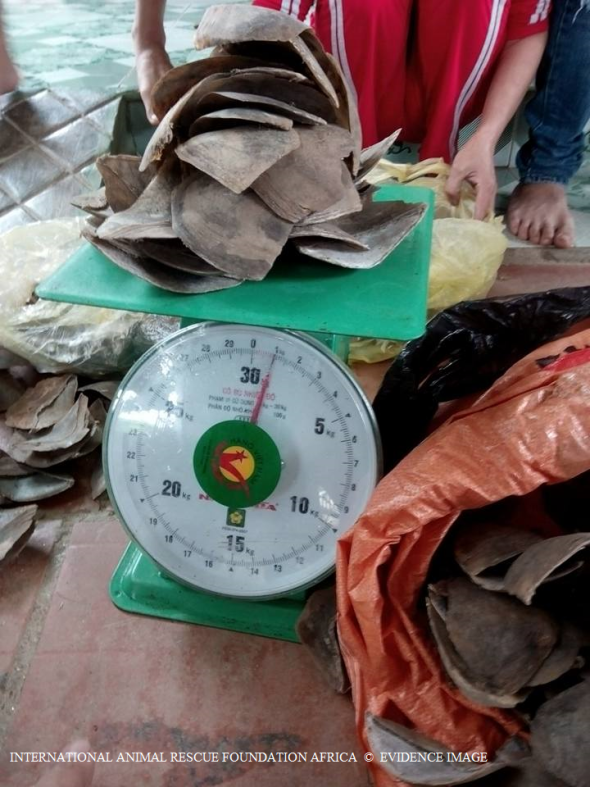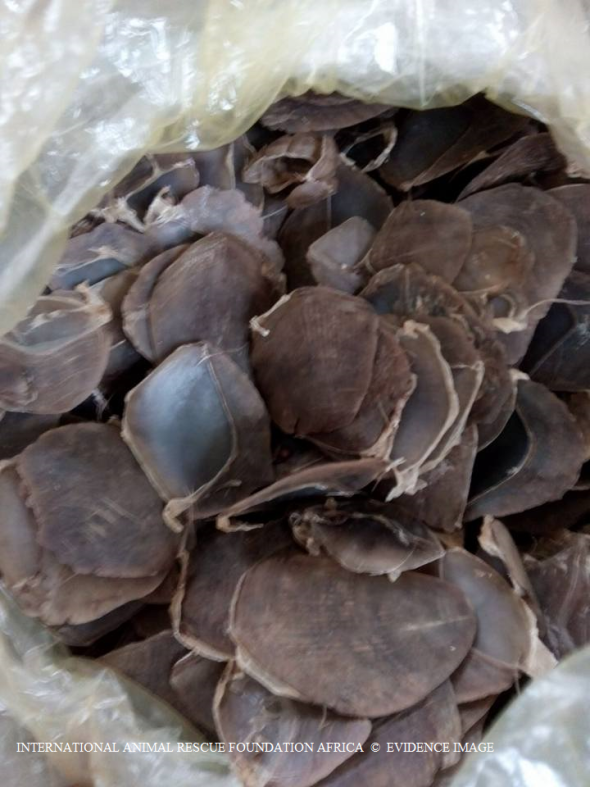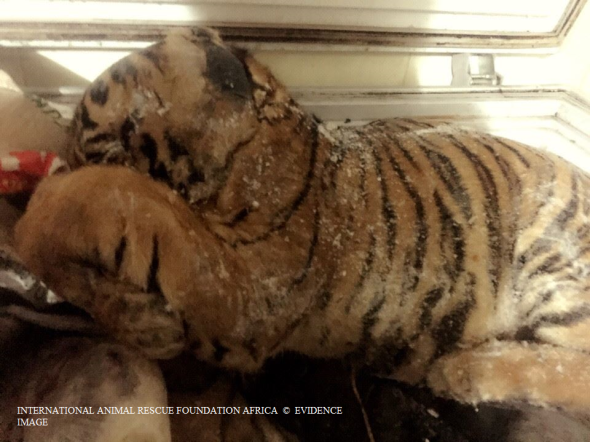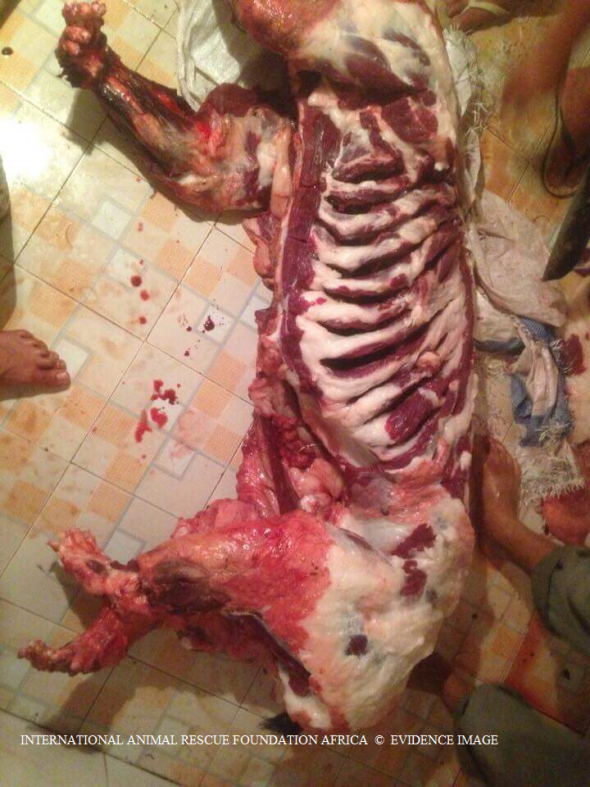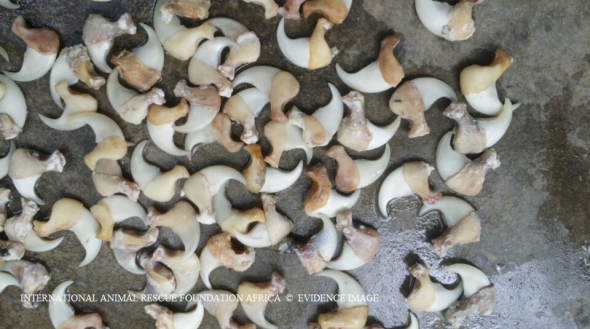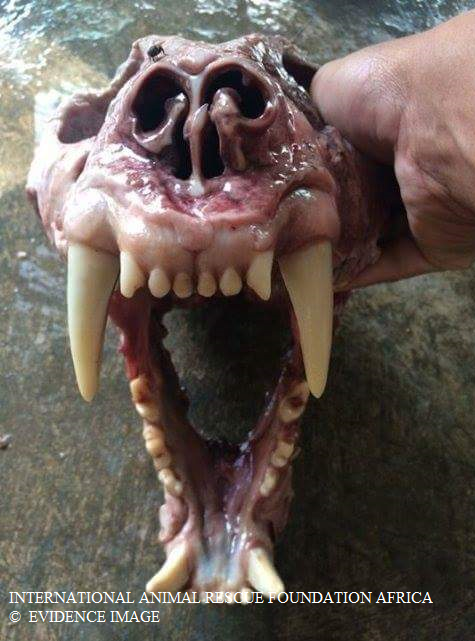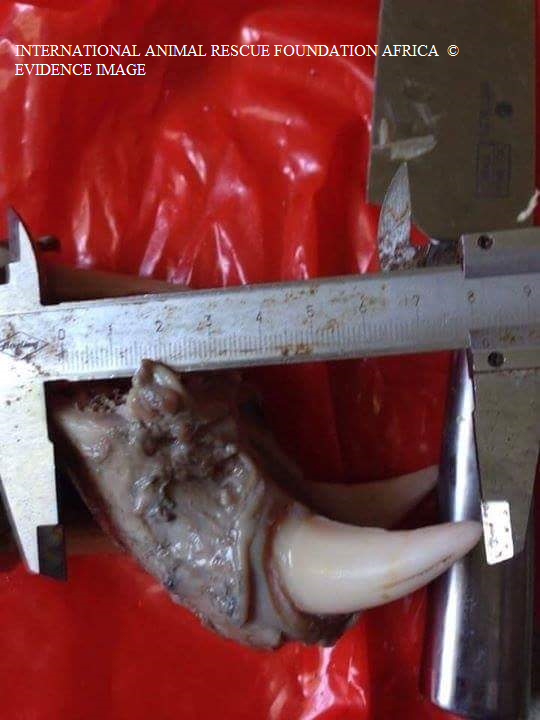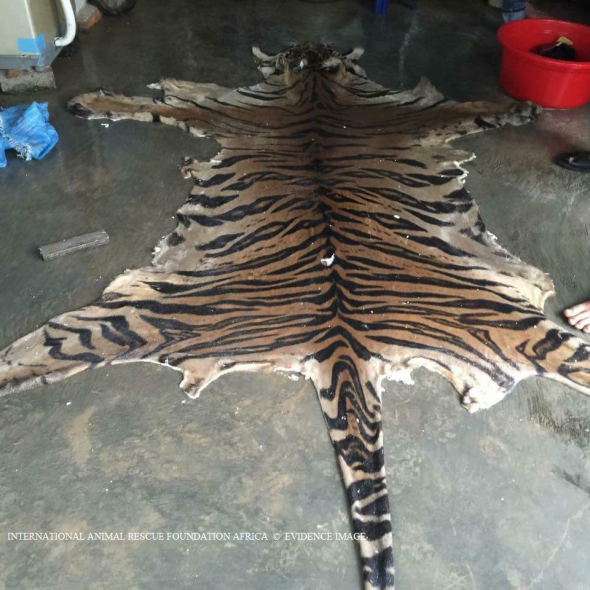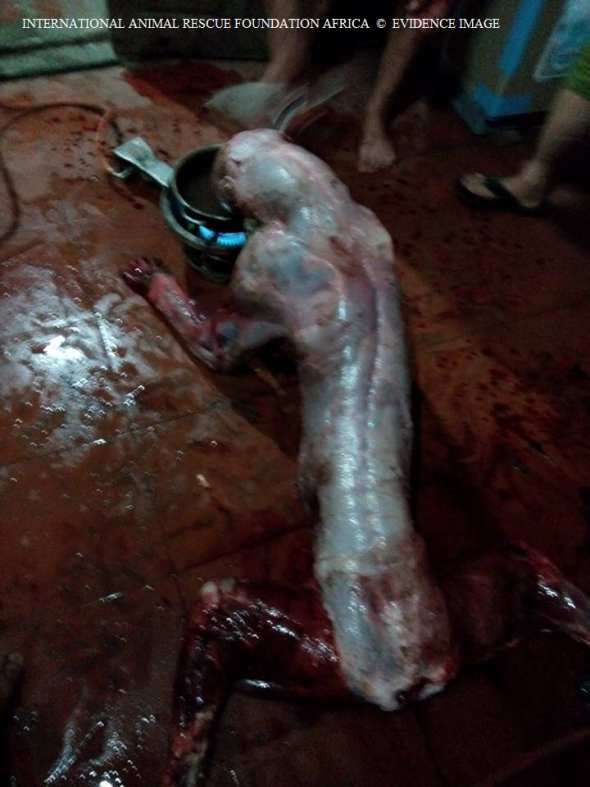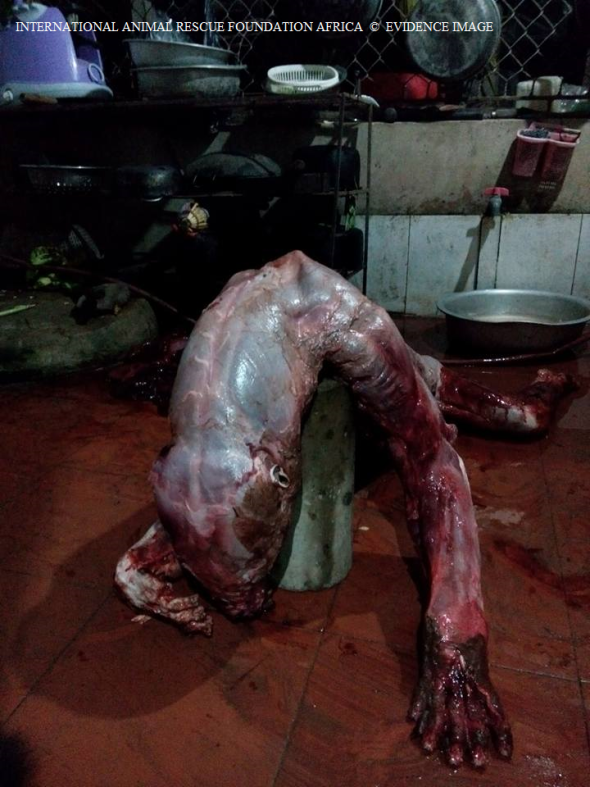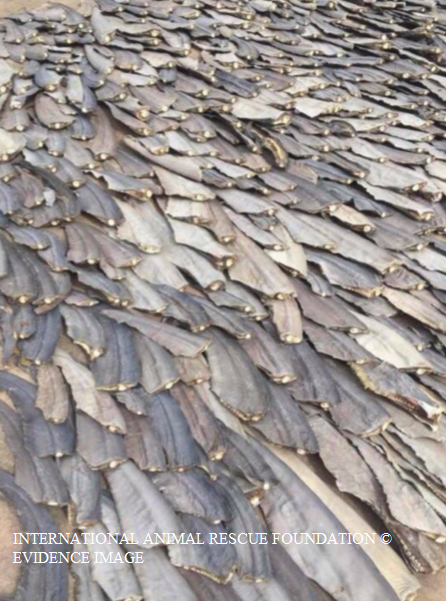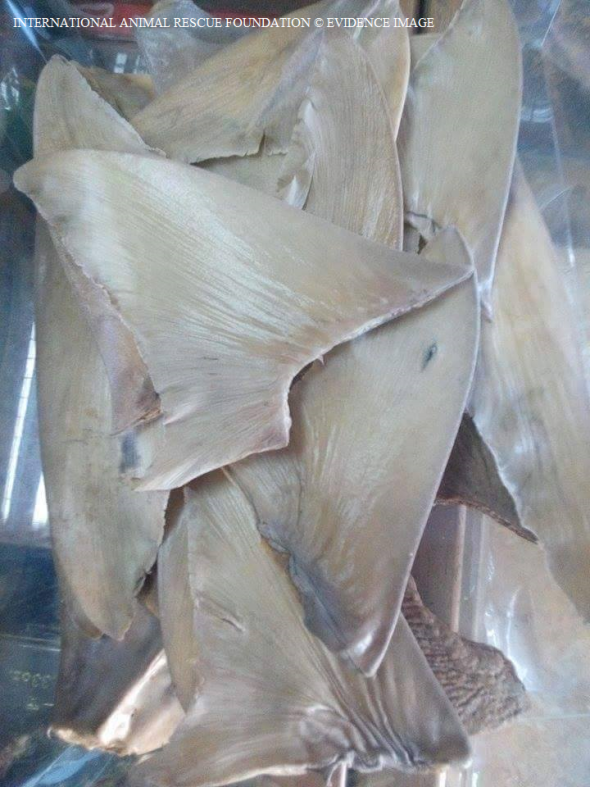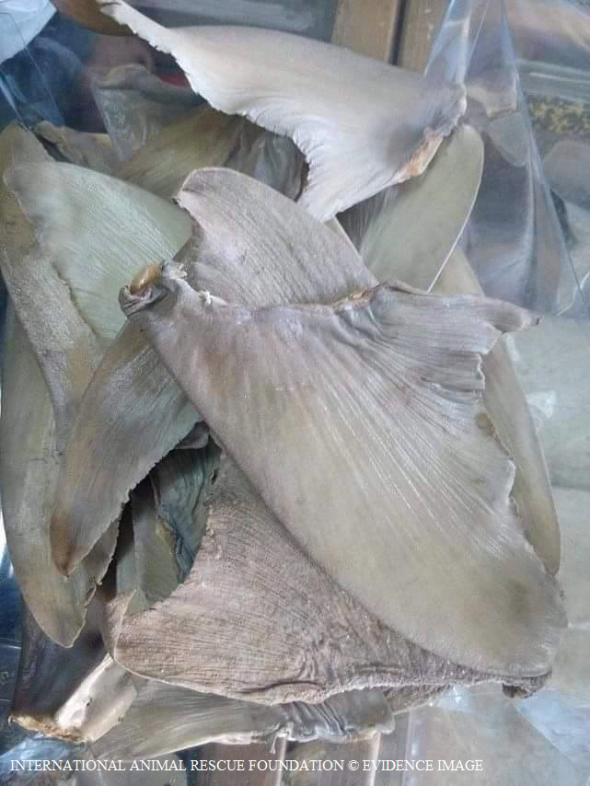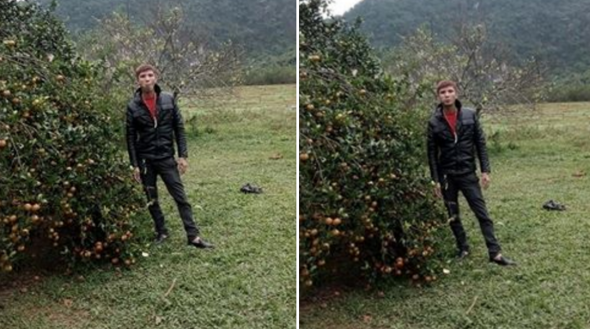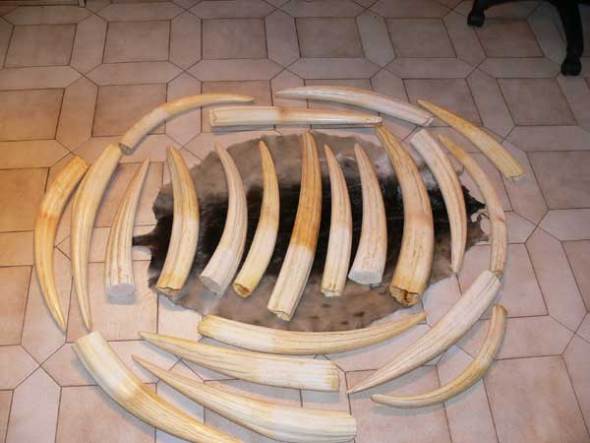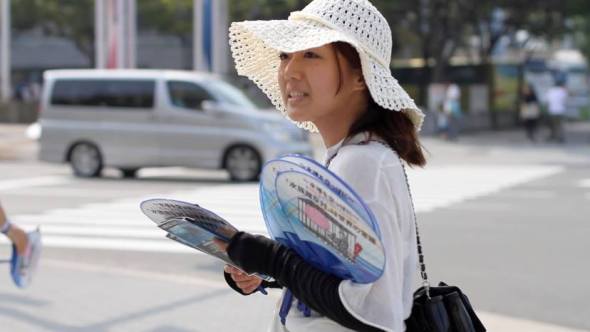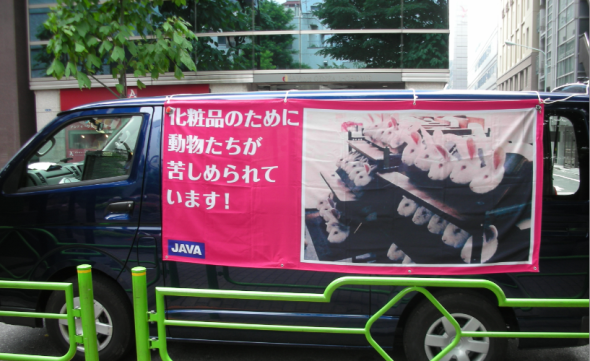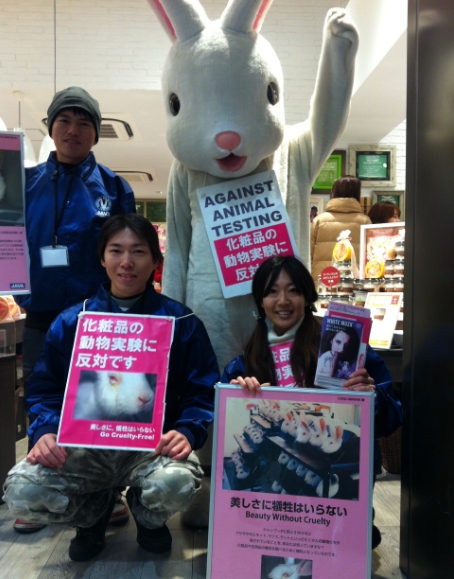TOREO | THE BULLS STORY - LA FIESTA NACIONAL.
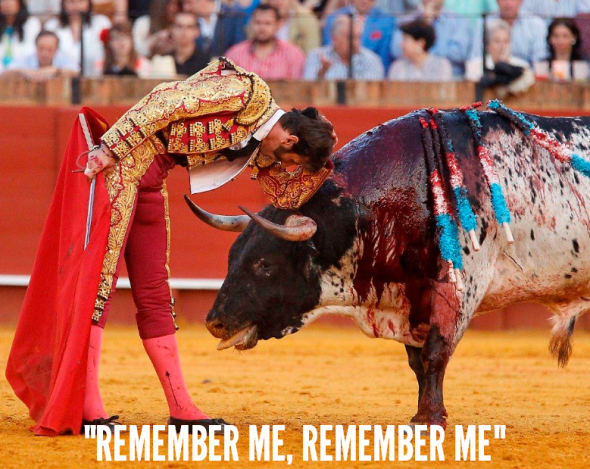
TOREO | THE BULLS STORY
HISTORY
Toreo. Just the word brings back horrific flashbacks of the many times myself and friends working within the Animal Rights Militia have taken on the matadors and their deranged, psychopathic fiends, that revel within this brutal festival. The last account five years ago was when we stormed a bullfighting ring. Not only was we spat at by the crowd, we were also beaten over the head, shoulders, and body - Police deliberately turning their head as pepper was rubbed within our eyes. Water cannons shot at us, female activists chained together with us all screaming as the matadors fiends attacked, welcome to Spain.
That’s the level at which these sadists drop to, just to protect their so called brutal and gory cultural tradition. Police then, after each activists chain was cut, dragged each of us away, before imprisoning each individual for illegal trespass, and various public order offences. Forget the bull though that’s beaten, lanced, and brutally tortured (even before the festival begins). Oh, didn’t you know? What, you thought the bull was only abused during the event? No, far from it. Every single bull before they even enter the bullfighting ring are lanced, they have pepper or Vaseline rubbed within their eyes, and are also stabbed within their genitals just to weaken the bulls strength. The spectators believe that this strong, proud, and daring matador is actually fighting a strong and powerful bull. Far from it!
“Stabbed in the genitals - Vaseline rubbed into the bulls eyes”
Bull fighting in Spanish known as (Toreo) has been a part of Spanish tradition now for many hundreds of years. The “cultural tradition” dates as far back to the 1700’s, which then was a traditional event reserved primarily for the wealthy nobleman. Today the so called tradition is now watched by families both poor and wealthy, children and even celebrities. Today we see a man or woman known as a (matador) standing within the ring taunting and aggravating the bull.
It’s quite uncommon to witness now anything other than the matador within the ring. From the early 1700’s right up to 2008 horses were still used by matadors (and are still used within some events). Unfortunately as one can see within the image below, these forgotten victims (despite the masses armor protecting them) in many cases would be the bulls first victim. But why horses?
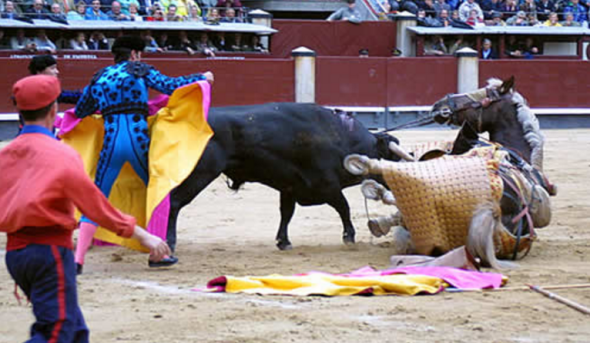
Image: Bull gorges the horse, often in many cases dying from their injures.
The tormented bull does not understand that it is the man on the horse’s back that is causing his pain, only that he is in agony. He therefore sees the horse as his enemy as much as the man. It’s not unusual for horses used in bullfights to be so badly gored by the bulls that they have to be killed, but only after they have been dragged from the ring and the view of the spectators. Spanish bullfights also employ “picadors”, men on horseback armed with spears.
Horses are often the “forgotten victims of the bull fighting tradition”. Rarely are they mentioned within the press, or the media, their pain etched deep within their eyes after the bull gorged them, before yet another sadist fires a bullet into the horses head - killing them instantly releasing them of further misery and pain. What a waste of an animal - all for a so called cultural tradition!
I’ve documented on many bullfights now, however, today, refuse to part with my money just to provide it to sadists. I’ll admit now, even a grown man, hardened by the sights and sounds of animal torture tears were and still are shed, knowing I couldn’t do a single thing to stop this animals pain, witnessing them up close, the pain clearly visible within their eyes, in a sense pleading with me or someone to help them, reminding me in a sense to remember them.
The horses are blind-folded to prevent them from becoming terror stricken at the charge of the bull. It is commonly believed that their ears are stuffed with cotton-wool to prevent them from panicking and their vocal cords cut to stop them screaming with fear at the bull’s attack. This is the fate of these beautiful animals. To be used to entertain a crowd that lusts for blood and claims that bullfighting is a tradition and “cultural heritage”.
“Horses ears are stuffed with cotton-wool to prevent them from panicking and their vocal cords cut to stop them screaming with fear at the bull’s attack”
What about the brave matadors, picadors and their ilk? Bullfighters are rarely injured and seldom killed in the ring. With their armory of weapons to weaken the bull until it can no longer fight, their lives are not at great risk. In fact, in the last 50 years only 10 bullfighters have been killed worldwide. The last gimp that was gored by a bull and killed was back in July 2016, identified as Victor Barrio. In my humble opinion his death wasn’t gory enough, and I’d have quite happily paid good money knowing he was going to be gored to death slowly and sadistically just to send my love as he departs this grotesque and evil world to hell.
Many people believe that bullfighting is only confined to Spain, if only? Bull fighting is hosted in various countries around the planet - mostly European. Spain, Portugal and France are the main three European countries where bull fighting is still legal - although in France activists are fighting back hard, and I do believe that France is soon to kick this horrifying cultural tradition out off the back door for good. India, United States of America, and Tanzania all host bull fighting events too. Furthermore in India, Persian Gulf, Japan, South East Asia, South Africa, and Kenya host “bull wrestling events”, again the bull is brutally killed.
Building of the Maestranza Bullring in Seville began in 1758 making it Spain’s oldest Plaza de Toros. The origin of modern day bullfighting on foot (rather than horseback) can be traced back to Ronda. It is one of the most charming bullrings in the country and although its capacity is only 12,500, it attracts the top bullfighters. You can see bullfights in Seville from April (during Seville’s Feria de Abril) through to October. The video below is one on of the most barbaric so called “cultural traditions” I’ve ever witnessed!
“THIS IS SPANISH CULTURE”
LA FIESTA NACIONAL
The Spanish bullfighting season is normally hosted from April into October every year. However within the past decade activists have finally had enough - and today its not uncommon to see activists, and the (locals that support this so called “cultural tradition” facing off with one another within the streets). Violent clashes are at times known to explode outside of the ring and within the ring. The whole purpose of these clashes is to disrupt the event and reduce as many “paying spectators” from gaining access. The more financial disruption can be caused - the quicker these events slowly, but surely come to an end. Please view the video below.
Many spectators that attend the local Spanish bullfighting festivals only witness what is ongoing in the ring before, and after. They are rarely (if at all told) how the bull is acquired, what happen’s to the bull before the festival, and if the bull is lucky - what happen’s to the bull after? I myself believe that if all of these spectators truly knew what happened prior, during and after they’d never attend another bullfighting festival again.
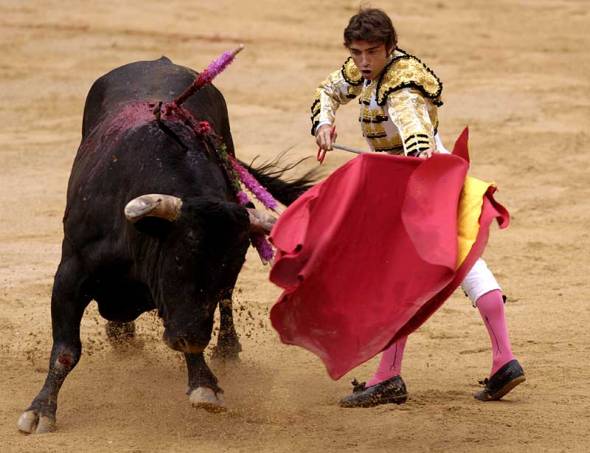
Image: Matador begins preparation for the kill.
As explained above most if not all spectators only witness the bullfighting match; well if you’re one of them spectators (reading this article) then now is the time to read the following gruesome and rather upsetting facts - just so you know how cowardly this so called cultural tradition truly is!.
PRE-FIGHT
The bull is not an aggressive animal (nor does his charge at seeing red), and the reason he is angry and attempts to charge at the matador whilst in the bullring is mainly because he has been horrendously abused for the previous two days. In fact, what spectators see is not a normal, healthy bull, but a weakened, half-blinded and mentally destroyed version, whose chances of harming his tormentors is virtually nil. The bull has wet newspapers stuffed into his ears; Vaseline is rubbed into his eyes to blur his vision; cotton is stuffed up his nostrils to cut off his respiration and a needle or knife is stuck into his genitals.
“The bull has wet newspapers stuffed into his ears; Vaseline is rubbed into his eyes to blur his vision; cotton is stuffed up his nostrils to cut off his respiration and a needle or knife is stuck into his genitals”
Also, a strong caustic solution is rubbed onto his legs which throws him off balance. This also keeps him from lying down on the ground. In addition to this, drugs are administered to pep him up or slow him down, and strong laxatives are added to his feed to further incapacitate him. He is kept in a dark box for a couple of days before he faces the ring: the purpose of this is to disorientate him. When he is let out of the box, he runs desperately towards the light at the end of the tunnel. He thinks that at last his suffering is over and he is being set free — instead, he runs into the bullring to face his killers and a jeering mob.
“A strong caustic solution is rubbed onto his legs which throws him off balance”
THE BULL FIGHT
The above “pre fight description is 100% factual” - I’ve seen it with my own eyes, and have spoken to various ex-matadors (that also verify mine and others claims) that are now friends with myself - fighting to end this gruesome cultural tradition. Furthermore its not just the bulls that are abused, as explained above, horses are treated in more or less the same horrifying manners.
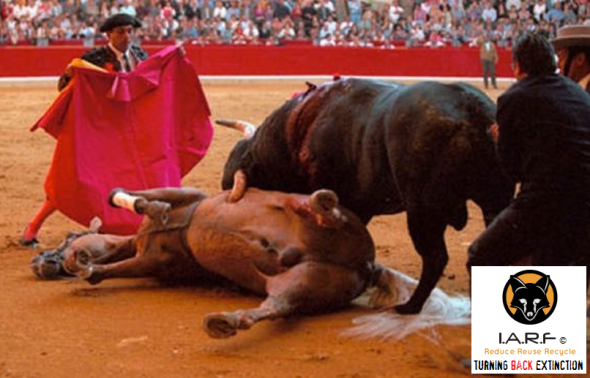
Image: Frightened horse - gored and unfortunately killed.
Strictly speaking, a bullfight is composed of 3 separate “acts”, and the whole thing is supposed to last for 20 minutes, though in actual fact it varies. The opening of a bullfight begins with a tune being played on a trumpet — the tune is the special, signa lure Rifle which characterises the beginning of the horror. Upon entering the ring, bulls have been known to collapse through exhaustion alter their pre-fight ordeal — they have been dragged to their feet by the bullfighter’s assistants. Below is a video of the “forgotten victims” - horses. The video I believe was recorded in Peru or Mexico.
THE PICADORS
The sequence of events begins when the bull faces the picadors — these are the men on horseback, whose purpose it is to exhaust the bull. They cut into his neck muscles with a pica. This is a weapon of about 6-8 inches long, and 2 inches thick. Once it is thrust into the bull it is twisted round and a large, gaping wound appears. The bull then starts bleeding to death. But why can’t the matador do this - a man that is so strong, so fearless and is scared of no beast? Well its simple. The matador requires the help of three to four other gimps because there is no way he’d safely be able to deliver that first blow thus weakening the bull as he (cowardly attacks the animal). Isn’t that how bullies in the school playing field behave? The image below depicts various weapons and a pica - a rather crude weapon that the picadors use to weaken the bulls strength, so the coward in woman’s clothes can take the bull down with ease.
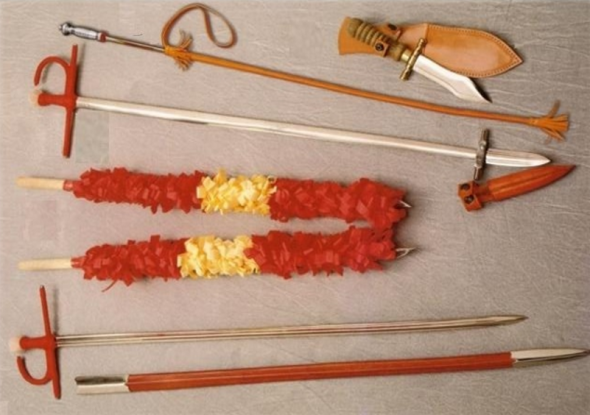
Image: Pica and Banderilla.
Pica’s and Banderilla’s vary in shape and size, there really isn’t any specific shape although most picadors will tend to chose a slim, and sharp pica or Banderilla, so as to not quicken the loss of blood from the bull. Furthermore the slimmer and finer the blade - the easier it is to stab into the bull. The last thing a picador wants is to be battling within an already pissed off bull that could take the horse down (which it does sometimes) and potentially kill the picador too. The above image is an example relating to the bladed weapons used by picadors, and matadors.
ASSISTANT MATADORS
After the picador has finished his sordid and rather sick, perverted business, the assistant matadors then get to work with the banderillas (sharp, harpoon-like barbed instruments seen in the image above). These are plunged into the bull’s body, and he may also be taunted by capes (seen in the image below). Up to six banderillas may be used. When the banderillas strike the bull stops in his tracks and bellows madly.
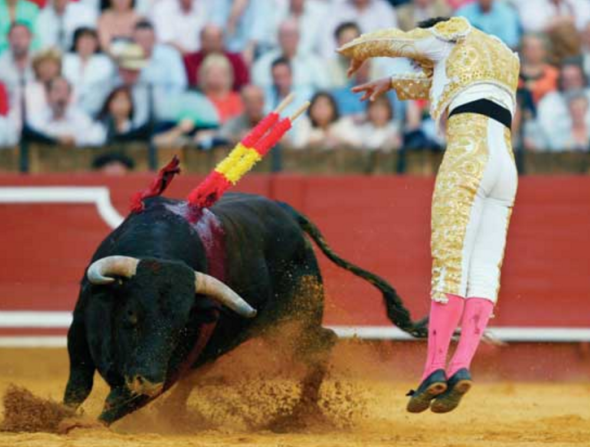
Image: Matador plunges Banderilla into bull.
THE FINAL ACT OF BARBARITY
A trumpet signals the final “act” — in fact, during the whole nightmare, strange, slow tunes are played throughout. It is, of course, during the final act that the bull is killed (and hopefully goes onto a better life). The kill should last 6 minutes, and is done by the main matador. If he has any difficulties (which is an extremely rare occurrence), the others immediately rush in to his aid and finish off the bull. While death may take some 6 minutes - brain death takes over 30 minutes if not longer.
THE FINAL DEGRADATION
The matador is supposed to sever the artery near the heart with one thrust of the sword — in fact, this never happens. It often takes 2-3 times before the creature is mercifully released by death. By this time, the bull’s lungs and heart will be punctured and he always vomits blood. Miraculously, he sometimes attempts to rise again, and gets up on his knees, only to receive further mutilation at the hands of his tormentors. He finally gives up, goes to his knees and lies down. Even then, he is not allowed a little dignity to leave this world in peace, his ears and tail are cut off (often when he is fully conscious), and his broken, bleeding body is dragged around the ring by mules, to which he is attached by an apparatus made of wood and chains. Not content with his suffering, which must be too horrible to describe by words, the crowds boo and jeer him. They even throw empty beer cans at him. His body is then taken away to be skinned, and even then he may not be dead when this happens.
“THIS IS SPANISH CULTURE?”
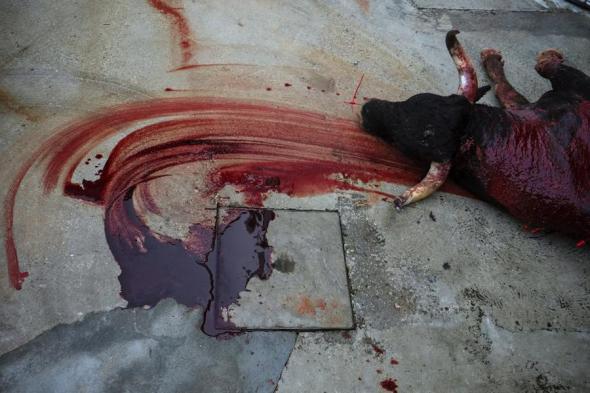
Image: Bull is dragged away after being brutally and sadistically killed.
THE JUDGES FINAL DECISION
To be brutally honest I don’t really know what’s worse. Watching the matador or picadors rain merry hell down on the bull, the bull vomiting blood, and suffocating on its own blood, the bull collapsing to his feet unable to take a further onslaught, or the judges final decision on how the fight went?. Once the bull has collapsed and begins the slow several minutes of painful death. Judges will rule on how well the matador fought. Traditionally when the bull is down and unconscious, judges will decide whether to cut off one ear (for a good fight), two sliced ears means (an excellent fight), or two ears and the tail (bravo - the best fight they’ve witnessed).

Image: Female Matador Lea Vicens sliced the two ears off (excellent fight).
IF THE BULL GORES THE MATADOR TO DEATH?
When I posted about Victor Barrio’s death, many people reveled about his death, cheered the bull, while many more truly believed that was it, the bull had won, and that was that. Unfortunately within Spanish tradition that’s not how this so called “culture” concludes matters. Bulls are bred by the local farmers, of which the farmer will chose the very best bull to enter the ring. 100% of all bulls that the local farmer will be presenting to the ring - are 100% free roaming and wild. So you’d kind of think, that should the bull get lucky the bull will be returned back to the farmer and treated by a veterinarian, and hailed as an animal hero? Think again! Feel free to leave Lea Vicens a message on Facebook here
Far from it. The bull hasn’t a chance. Its either take the matador on and lose - of which the bull is then skinned and fed to the locals, or take the matador on and kill the matador, of which unfortunately the bull will still die. Those lucky bulls that (incredibly rarely) are able to take the matador down and kill him or her, will be sent to slaughter. As an environmental and human scientist and qualified veterinarian I find the latter quite mindbogglingly odd. Should a bull win or even lose that’s been scared witless, put through hell, of which its body has been pumped with stress hormones and adrenaline prior and during the battle. That meat will be toxic and tough to eat. So in a sense the bull is (if they win or lose) getting their own back on the local community either way!.
THE BULL ALWAYS HAS THE LAST LAUGH
Stress, fear and pain when animals are being slaughtered or waiting to be slaughtered results in several disease processes in the humans which eat the meat. Most notable are cardiac problems, impotency and general fatigue. These adverse effects are most directly associated with consumption of dog meat (simply because there is no dog meat slaughter regulation - and in this case with the bull that wins or loses - no regulation on disease neither). Experiments including laboratory dogs slaughtered in stressful conditions result in impotence of rats fed with the dog’s meat. These results correlate with studies of humans in St. Georges, Utah.
Studies made of domestic farm animals (cattle, pigs and poultry), and of laboratory animals (dogs and rats) show in all cases elevated levels of steroid hormones, generally associated with adrenocortical secretions. Primary substances include adrenaline, cortisone-like secretions, and steroids which stimulate fear pheromone production. All of these are known to result in poor health and poor vitality. This study confirms this link in food consumed by humans.
I’ve studied human, wildlife, botanical and environmental science for many, many years. I’ve written over 4,000 articles for press and the media and talked on radio shows within the past decade around the globe. However during all of these articles, including my own organisations articles I’ve never written about such barbaric, repulsive, and backwards so called cultural traditions. Nevertheless - and regardless of how long these so called cultural traditions continue I and my fellow companions as well as the media and press will continue to fight on to end this barbarism.
Five years ago I looked into a bulls eyes and cried my heart out watching the bastard matador slowly and sadistically kill the bull in front of me and many hundreds of jeering spectators. I felt in a sense that the bull was asking me to remember him, and as yet been unable to explain that story in full. So this time I’ve remembered him, released that horrific memory from my mind. I’ve told his side of the story - a story that is rarely told to the witnessing public. Remember him I damn well did. I’ll never forget neither.
Thank you for reading, and to follow my of my articles stay tuned to my main site >here<
Dr Jose C. Depre PhD. MEnvSc. BSc(Hons) Botany, PhD(NeuroSci) D.V.M.
Environmental, Botanical & Human Scientist.
Chief Executive Officer | Chief Environmental Crimes Officer.
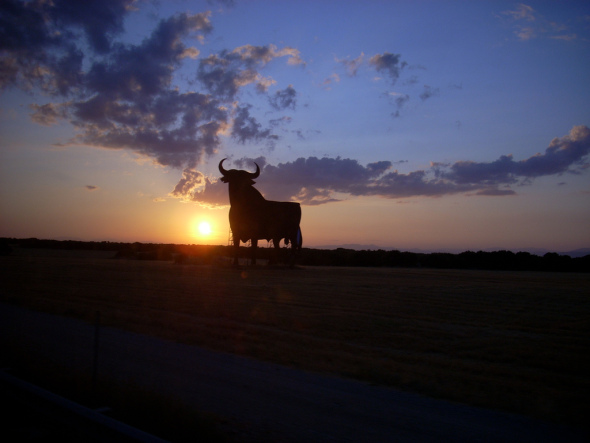
Endangered Species Monday: Papustyla pulcherrima | Special Report.
Endangered Species Monday: Papustyla pulcherrima
Manus Green Tree Snail - Very first invertebrate to be listed on the Endangered Species Act of the United States of America (2015) Endangered Species Post Special Report.
This Monday’s Endangered Species Post (ESP) I take a wee glimpse into the life of the Green Tree Snail, also commonly known by Papua New Guinea’s natives as the Manus Green Tree Snail. Image Credit: Stephen J. Richards.
Identified by Professor Rensch 1931, Rensch was born on the 21st January 1900 in Thale in Harz and died on the 4th April 1990 in Münster, (Germany), Professor Rensch was an evolutionary biologist, zoologist, ethologist, neurophysiologist and philosopher and co-founder of the synthetic theory of evolution. He was professor of Zoology and Director of the Zoological Institute at the Westphalian Wilhelms University in Münster. Together with his wife Mme Ilse Rensch he also worked in the field of Malacology and described several new species and subspecies of land snails.
The Manus Green Tree Snail is identified as Papustyla pulcherrima commonly known as the Emerald Green Snail. From 1983-1994 this particular species of snail was considered (extremely rare). Back in 1996 when scientists managed to again finally catch up with this stunning little mollusk, the species was then listed as (data deficient) of which to date there remains little information about this (rare) but beautiful snail.
P. pulcherrima is endemic to the Papa New Guinea northern island of Manus of which the species is listed as (near threatened), and has also been reported on the adjacent Los Negros Island. Environmental scientists have confirmed from villagers on the main Manus Island that the species is not located anywhere else. However there are some sketchy reports that the species “may be located on surrounding islands”, however there is no evidence to back these claims up.
Environmental scientists have confirmed for now that the species is located in only 12-13 areas of the Manus Island[s]. Further reports have confirmed that mature individuals are on the decline (which if not controlled could evidently see the species re-listed as vulnerable or endangered). The Manus Green Tree Snail is not believed to be living within fragmented zones. The species is restricted to forest and low intensity garden ‘type’ habitat. Declines have been noted within all 12-13 identified habitats on the Manus Island and adjacent Los Negros Islands. Population history is pretty much undocumented although has been shown to be slowly declining.
Image: Manus Green Tree Snail.
Back in 1930 when Professor Rensch identified the Manus Green Tree Snail, locals soon began collecting the species for trade thus seeing the mollusk now nearing endangered listing. Demand for the Manus Green Tree Snail has now drastically increased threatening the species furthermore. Locals continue to collect this rather unusual colored species shell for use within the jewelry trade. There are now “very serious concerns” that trade may eventually push the species into extinction.
Due to mass trade exploitation the Manus Green Tree Snail is the very first invertebrate to be listed on the Endangered Species Act of the United States of America. International trade has been controlled by export permit since 1975 under the Convention on International Trade in Endangered Species of Wild Fauna and Flora (CITES) appendix II. Unfortunately this is not stopping locals from harvesting the species, and trade is still continuing despite it now a criminal offence under United States and some international laws.
“Overexploitation threatens the Manus Snail”
Market sales data collected from the Lorengau market, over a six day period suggest that annual sales at the market may approach 5,000 shells. Investigations by the Wildlife Conservation Society (WCS) reveal that large quantities of shells are still being attempted to be exported out of the country. Online searches revealed the sale of the shells, often marketed as antiques, occurring in open forums and internet market places based in New Zealand, Australia, and the United States of America (USA). International Animal Rescue Foundation has ran numerous traces online of which located yet again Ebay as being a number one trading site of the “threatened species”, please view the image below and click the image link that’ll direct you to that site.
“EBAY JAPAN IS A HOTBED FOR ILLEGAL TRADE OF THE MANUS GREEN SNAIL”
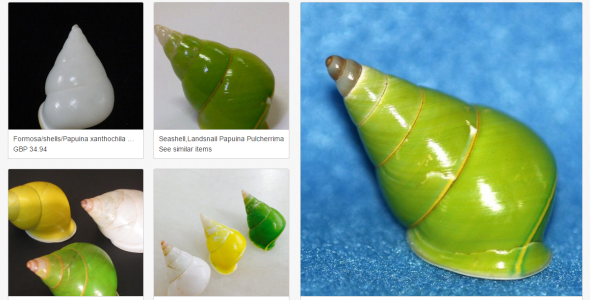
International Animal Rescue Foundation’s External Affairs Department and the Environmental Cyber Crimes Unit located many a sites trading the Manus Green Tree Snail’s shell which is illegal under some trade law, unfortunately the Ebay site listed above, located within Japan is one of many more that are trading (despite the species nearing extinction).
I.A.R.F’s Environmental Cyber Crimes Unit have since filed a complaint with Ebay, providing all the relevant data to now remove these species from their sites, however its likely to prove negative as the trader could very well state they harvested or purchased the shells before international laws were drafted. Furthermore a trace of the owner that owns this site above which is in violation of the United States and Cites laws (is located within the United States). So in regards to enforcement, breaking this link is going to be somewhat of a tough cookie. Further trade was witnessed here via what we can only believe is alleged “antiques”.
Further trade all of which is illegal has been recorded hereto - this site linked back to a Mr Rob West of 121 Henderson Road, Sheldon, Brisbane, Queensland 4157 Australia, Telephone: 610732061636. Mr West from Brisbane categorically states that he doesn’t own a shop, and is a one man band, yet clearly this link states otherwise. Further evidence revealed antique trade conducted on the Ebay site, see in the image below (illegal under United States law).
Click the image link below to view more.
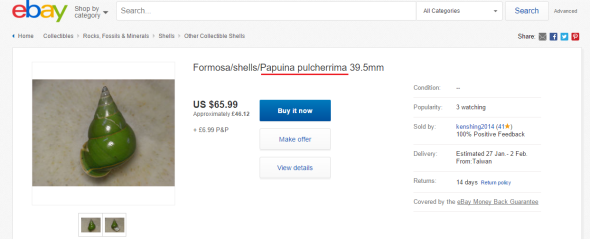
“Illegal to trade under the Endangered Species Act of the United States of America”
The environmental wildlife crimes investigation team linked to TRAFFIC and Cites stated:
It is possible the avoidance of conventional nomenclature is an attempt to avoid detection by authorities. In some cases, sellers on internet market places were based in CITES signatory countries (including: Australia, Italy, New Zealand, Singapore and USA) while others were not (e.g. Taiwan). Currently, volumes of shells on sale in such online market places appear low, suggesting that the existing controls on international trade maybe adequate. However, given that the online prices of shells were often orders of magnitude greater than market prices on Manus Island, vigilance will be required to insure that illegal international demand does not fuel a resurgence in snail collection.
Despite the massive trade on Manus Green Tree Snails online and within open Asian markets, its literally impossible to determine if this trade will eventually lead to the species being pushed into extinction. However it MUST be noted that there are currently only 12-13 identified habitats that the snail currently inhabits. And based on traces online conducted by the I.A.R.F’s External Affairs Department - trade is most certainly “out of control”, and not as Cites has reported (2012).
The shell of this species is a vivid green color, which is unusual in snails. The green color is however not within the solid, calcium carbonate part of the shell but instead it is a very thin protein layer known as the periostracum. Under the periostracum the shell is yellow.
MAJOR THREATS
The Manus Green Tree Snail is mostly threatened by habitat destruction through forest clearance: logging, plantation development (especially rubber) and to a lesser extent road developments. Increasing human population growth and an increasing cultural demand for deriving cash incomes from the land will likely see the rate of forest degradation increase in the future. Harvest occurs when trees are felled as part of traditional shifting cultivation and the snails, typically found in the canopy, suddenly become exposed. Such harvesting is not uncommon but it is likely to be of lower significance than the longer term habitat degradation caused by such agricultural practices.
While harvest for illicit international trade is occurring, the volumes are not “allegedly” thought to be large compared to historic rates, although they may approach levels seen in the legal domestic trade. However, given that the prices of shells internationally are often orders of magnitude greater than market prices on Manus Island, vigilance will be required to insure that illegal international demand does not fuel a resurgence in snail collection.
Notable deposits of gold have been found in central Manus and a mine operation will likely result in the next decade although no details of the plan have been released (as of 2014). The forests of Manus Island were badly affected by the 1997-1998 El Niño which resulted in a prolonged drought. Should climatic change result in increased rates of similar conditions this may constitute a future threat to the snail species, however, current predictions suggest that future incidence of drought in Papua New Guinea will decrease (Australian Bureau of Metrology and CSIRO 2011).
Despite the reassurances from Cites, WCS and the local wildlife organisations - evidence clearly points to large scale online trade legal and illegal. Furthermore there is no telling if shells online are antique or smuggled from the Manus Islands which is very concerning.
Manus Green Tree Snail is the first such snail to be listed on the threatened list of endangered species (USA). Research also explains to us that its likely the species will be plundered into extinction - very soon. Enjoy the video.
Thank you for reading, and please be most kind to share to create awareness and education.
Dr Jose C. Depre PhD. MEnvSc. BSc(Hons) Botany, PhD(NeuroSci) D.V.M.
Environmental & Human Science
Donate by clicking the link below:
https://www.facebook.com/Anti-Pet-and-Bush-Meat-Coalition-474749102678817/app/117708921611213/
Sign up here to our A.P.B.M.C news feed below here:
https://www.facebook.com/Anti-Pet-and-Bush-Meat-Coalition-474749102678817/app/100265896690345/
Follow me on Twitter here:
https://twitter.com/josedepre11
Sources:
IUCN, WWF, CITES, WCS, Ebay, Wikipedia, Australian Bureau of Metrology and CSIRO
Illegal Wildlife Trade | Investigative Report | Viet Nam & Thailand.
ILLEGAL WILDLIFE TRADE IS BOOMING
WARNING - THE FOLLOWING INVESTIGATIVE REPORT IS GRAPHIC
Investigative report written by: Dr Jose C. Depre.
International Animal Rescue Foundation Africa and her External Affairs Environmental Investigations Department commonly known as the (EAD), have for the past year been warning police agencies, and Interpol internationally and locally to tighten the grasp on the black market illegal wildlife traders, after a sudden spike was witnessed by us in trade emerging from Thailand and Vietnam (2013-2014)? IARFA’s External Affairs operations unit were somewhat suspicious as to why so many rhino and elephants were being poached, yet very little in the way of fresh animal parts I.e rhino horn and elephant tusk were being seen on the ground.
Back in 2014 the BBC reported that rhino horn and ivory in Viet Nam and China had heavily decreased (or was becoming more difficult to obtain), we disagree with the BBC’s 2014 documentary and have shown the evidence below to prove that trade is more than active in Viet Nam, with Thailand now the new rhino horn hub. We’re unsure as to what has caused this sudden increase of illegal trade and poaching in Africa and Asia, and the skyrocketing demand online, primarily on the United States social media platform identified as Facebook. What investigators located in the past year has shocked us, and has led to a multinational investigation spanning over 19 countries, resulting in IARFA’s biggest wildlife crimes investigation to date.
(NB: The following evidence depicted herein is of a graphic nature and viewer discretion is strictly advised).
A further concern was the sheer fact that rhino horn was becoming more difficult to locate on the streets of Viet Nam, which was also highlighted in the video below via the BBC (2014), yet rhinos are being slaughtered at some 5-7 a day on the African continent, primarily in South Africa. So we sent in our team of investigative officers to track down where we believed rhino horn and wildlife syndicates and traders were now in operation. The shocking evidence below proves what we believed all along. Thailand has become a hot bed for illegal rhino horn trade, and Facebook has yet again exploded with online illegal wildlife ‘profile shops’ and pet trade that criminals hide behind to peddle their trade on a grande scale.
Back in 2012 the External Affairs Department recruited a further twelve investigative volunteers due to worrying trade increases of mainly ivory, rhino horn and endangered tropical pets that were being sold at ground level, and on Facebook. Furthermore the (EAD) increased its online presence in relation to cyber crime projects run by Operation Trojan Horse founded in 2008 after it became apparent teenagers as young as 16 were illegally peddling animal parts and endangered tropical pets via their Facebook social media profiles.
While the (EAD) and her counterparts from the Operation Trojan Horse Online Surveillance Unit have been successful in locating and closing down illegal wildlife and pet traders (with arrests and seizures being made). Very little in the way of a decrease of demand and trade is being noted. Countless complaints to the United States Facebook platform with petition, hasn’t been successful either. Despite the fact illegal wildlife trade ranks as the worlds 4th largest illegal trade funding terrorism, narcotics, prostitution and child trafficking.
Over the past 365 days the External Affairs Department have been monitoring unusual peaks of the trade in rhino horn, ivory and tiger parts within Viet Nam, Thailand and Japan, with much online chatter from traders in Benin, Cameroon, South Africa and Namibia to Asian citizens peddling animal parts. Two individuals (pictured below) we’ve been wanting to catch up with now for over six months, after the duo skipped a meeting with two of our EAD officers in Thailand regarding the sale of rhino horn.
Its unsure if the two knew we were onto them, or they simply missed the meeting for unknown reasons. Either way and with a stroke of luck after data obtained from a bush meat trader in Cameroon we managed to catch up with our fiends again. This time the evidence we hold on them is so large it spans from Asia directly into Africa. From the 23rd December 2015 investigative officers from the EAD’s (Cyber Crime Unit) then moved into quickly obtain evidence to pass onto Interpol. From the 29th December 2015 (17:00hrs) we can now confirm the following evidence herein has prompted Interpol to now launch an ‘urgent investigation’ into serious wildlife crime spanning from Asia to Africa.
Had the meeting gone ahead back in June 2015 it would have led us ‘directly’ onto a more larger wildlife trading syndicate that we’ve been monitoring within Beijing, China since 2014, identified as Mr Ji Lu or Ken as he calls himself. Unfortunately the trail went dead, both the two young men and Mr Ji Lu vanished off the External Affairs radar. Then the EAD struck gold last week before Christmas after a random trace of a Cameroon bush meat poacher in Africa. We’ve long known that African bush meat poachers and traders communicate to Asian wildlife traders and syndicates either online in private chat forums, or via stolen cell phones. This time we had our men, more than enough evidence to launch a multinational investigation and further information that has led us onto newer more sophisticated traders.
“Thailand is the new hotbed for rhino horn trade”
However never did the EAD or ourselves believe we’d again come face to face with some of the most evil and sadistic animal parts traders we’ve ever encountered. If the images and evidence below is not enough to shock the Thai and Vietnamese Police into now acting, then we don’t know what is. The following evidence in image format below is shocking and may upset some of our readers.
However its no shock to us of which we have for the first time decided to show to over 7.8 million supporters exactly what we and other wildlife agencies are up against. Teenagers and young men and women from the ages of 16-20+ are trading anything from bear bile, real rhino horn, ivory, down to gorilla’s (all of which is strictly 100% illegal).
The two men above aged between 19-25 years of age we’re keen to catch up with again for their involvement in the brutal breeding and killing of innocent tigers for the bone wine trade. Furthermore the two individuals are also wanted for questioning for their involvement in the dealing and illegal possession of rhino horn and Elephant ivory. On conducting a random online trace the two men and possibly a female are believed to be using a pseudo Facebook profile that goes under the name of ‘White Tiger’ that has been set up as a female account. We believe we know whom the woman is, however as yet we haven’t 100% firm evidence to prove this is our woman from Japan.
(NB: Please note we cannot publish the identities of the two men and woman for legal reasons)
Its suspected that the woman’s name whom we believe is related to the two men above is Mme Phuong ***** whom possibly originates from Hanoi, Viet Nam, however we also believe that she goes under the name of Mme Chung. A further alias the female account uses on Facebook (not related to Mrs Chung) is identified as Cọp ******. The city that the two males and female accomplice frequents is identified as Phatthalung, Thailand. The home town of the Facebook account from which the female is ‘alleged to be residing within’ has been identified as Bang Kongra, Phatthalung, Thailand.
Furthermore a trace of the ‘accounts working address’ showed up as Bangkok ( กรุงเทพมหานคร ), which is a tourist company ferrying foreign and local tourists around Thailand. We have reason to believe that the female account possibly belongs to a Japanese woman that we have been following all over Australasia, who now runs an immigration agency on Facebook. However it must be noted that Mme Chung and Cop ***** are two different women. Confusing we know, we know though that both women and the men involved in this report are using 2-3 Facebook accounts and communicating in various chatter forums online!
The two men and one woman have for the past year been heavily dealing in rhino horn, ivory, and tigers that are brutally killed to produce an alleged medicinal wine (as seen above), rhino horn down to bear bile, narcotics (possibly heroin/hash (see image below)), and what appears to be counterfeit illegal cigarettes. The 1970/1990 and 2009 domestic and international rhino horn trade ban prohibits anyone from trading in rhino horn.
Meanwhile the 1989 ivory trade ban prohibits anyone from trading un-permitted ivory and ivory parts. Furthermore its a criminal offence (internationally and locally) to trade in anyone of the endangered species being that of pangolins and tigers. International Animal Rescue Foundation Asia successfully identified the many pangolin’s viewed for trade as the Manis culionensis or the (Philippine Pangolin). Hence why we had to move quickly to communicate all evidence to Interpol.

Illegal wildlife traders: Viet Nam & Thailand. Tiger cub was beaten over the head with Asian pangolins for the production of tiger and pangolin wine.
Back in June the External Affairs unit contacted the two men who’s names we’ve withheld in the hope to set up a deal to purchase rhino horn. Only one horn was available to purchase priced at $35,000 Vietnamese Dollars per/kilo. The horn had already been inspected by our Singapore counterpart that works closely within the trade circle.
The EAD officers then went ahead for the meeting of which as explained the two individuals didn’t turn up. Fortunately as explained we’ve managed to locate the two individuals again, this time though as you can see above and below, the two (possibly three individuals) have been rather busy since June 2015 (and way before they even cropped up on our radar). Some of the rhino horns can be viewed below along with ivory that is most certainly not permitted to be in the hands of these young men and women.
On locating further evidence that we required to instigate a multinational investigation we then again at 09:25am on the 23rd December 2015 and 29th December with a further communication on the 30th December 2015 communicated all (cyber evidence) and data to the Environmental Investigations Unit of Interpol via secure encryption. (Please note that are unable to provide all evidence onto this platform as it could/will impede on the investigation that is currently now ‘active’.
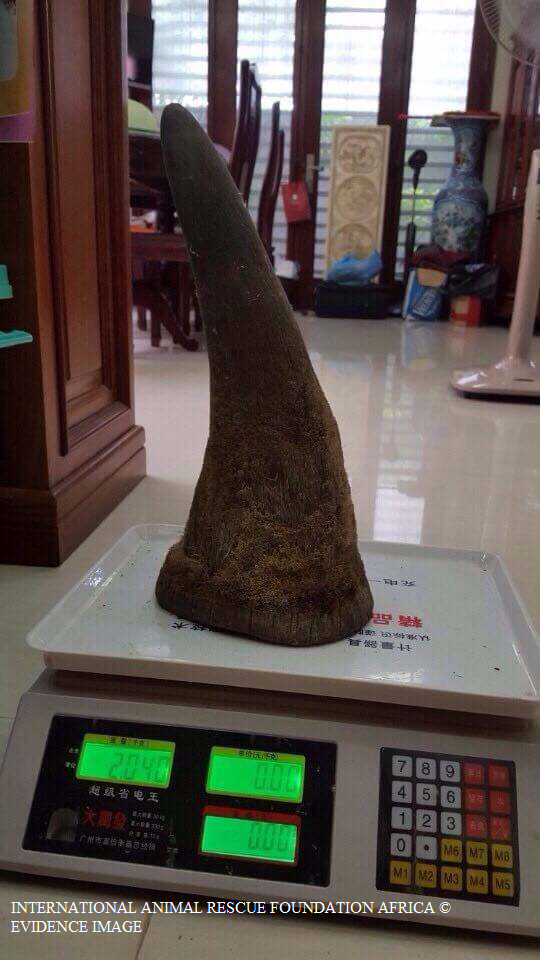
Trader weighs up a mature African rhino horn in back room. Total number of horns are worth in excess of 6 million euros.
Ivory trade was officially banned internationally back in 1989, however it hasn’t stopped these two rather sadistic and ruthless criminals from going about their trade bringing in millions of Vietnamese and Thailand dollars, most of which is traded on the US Facebook social media platform.
Furthermore it explains now where the vast majority of ivory and rhino horn is being traded. Viet Nam was virtually declared a no-rhino horn country by the BBC and the WWF back in 2014 as explained above. Unfortunately had the two investigations units bothered to look a little closer they’d have not only noticed our own concerns (with evidence being shown), but also many private online forums (including Facebook) booming in animal parts trade.
Below are numerous pieces of ivory all of which are not permitted. Investigate officers casually asked within the online chat forum if the ivory below was permitted, the [unnamed trader/peddler] was very forthcoming with his reply stating; “No, none of the ivory here is permitted”, meaning its 100% illegal to own/trade.
On immediately being made aware that the ivory was not permitted we knew instantly that these three individuals were not your average wildlife traders or syndicates. Furthermore on tracing the individuals Facebook profiles we were yet again (as explained) made aware of a female ivory trader that has been visiting Australia and Japan for unknown reasons while trading ivory online. Mrs Chung as we know her we’ve already informed the Australian Federal Police and TRAFFIC about.
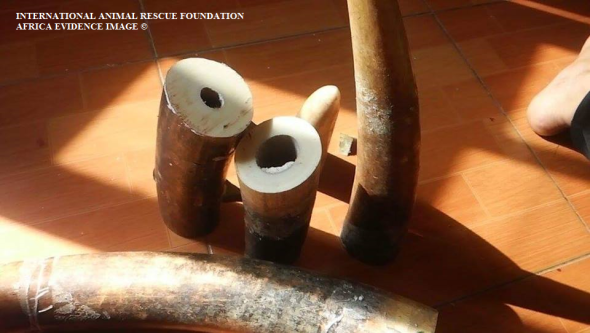
Female trader with male brags to investigative officer how ivory is easily obtainable from Benin via France.
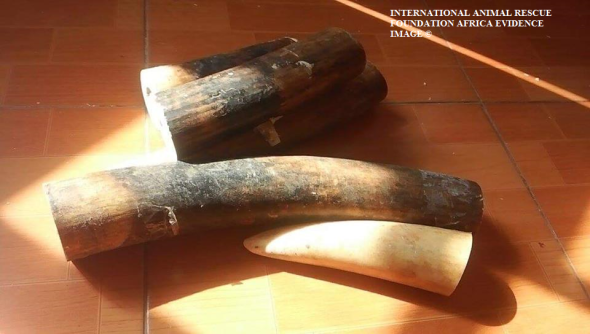
Trader informs investigate officer that ivory can be shipped into any county in the form of small firewood blocks.
The images above are just a small handful of evidence shots obtained from both the Vietnamese and Thai traders that had no worries whatsoever on displaying these items either to our investigative officers, or trading online via secure trading chatter rooms. These chatter room’s are mainly frequented by medicine men and women, and general traders of antique and non-permitted animal parts, all of which anyone can enter on Google using a simple VPN tool.
While ivory trade is not necessarily a big secret within Thailand, the sheer fact that younger people are able to obtain ivory and rhino horn in such mass quantities is extremely concerning. We also have reason to believe that some of the ivory is deriving from passages via Benin and possibly Cameroon on the continent of Africa. Our enquirers in relation to the African trail of ivory into Asia began with Mr Chan**** ***** who states he works for the Homme D’Affaire International which we believe is a made up organisation.
Chan**** *** runs a bush meat shop within Cameroon selling anything from pangolins to endangered turtles, masks and cars, and coincidentally his shop is also operational on Facebook. Had Mr Chan**** *** not bragged about ivory making its way from Benin into Vietnam we’d never have caught up again with our Asian fiends. Some of the images from Ch**** *** bush meat shop of horrors can be viewed below.
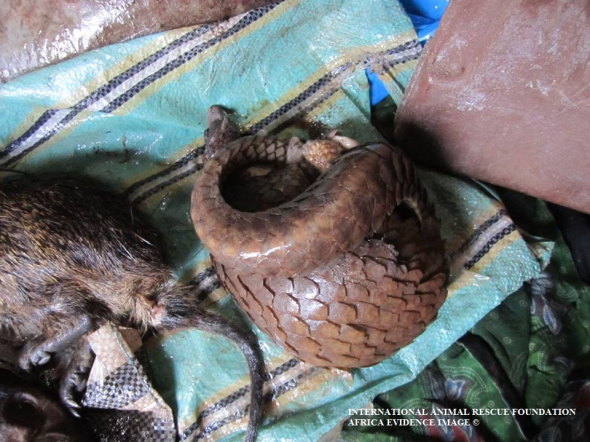
Investigators identified two species of pangolin. Both tie into the Asian and African wildlife traders.
E.A.D officers investigated the trade between the two African and Asiatic pangolins, above is that of an African pangolin which was the same species seen within the apartment of the Vietnamese citizen that offered our Singapore investigative officer rhino horn. So we’re 99% positive that all three Asian citizens have more than your normal ties to the African bush meat poacher whom we know is using a trade route from both Benin and Cameroon, onto Europe and into Asia. The African pangolin 1 of 3 identified in the apartment in Vietnam can be seen below.
African and Asian pangolins are fast becoming rare with the vast majority of Asiatic pangolins now nearing extinction. Pangolins are used within the Asian and African (TCM) Traditional Chinese Medicine trade. Furthermore the scales of the pangolins are used to make jewelry or coats. The meat of pangolins is considered a delicacy. Every year we loose more and more pangolins to poaching, and while the Asian pangolin continues to decrease in population size, the African pangolin will be placed more at risk furthermore.
Investigators were more shocked at the sheer fact that three young adults were able to obtain large quantities of illegal and legal wildlife products then freely trade them on the streets or upon their personal Facebook profile shop forums. The images below depicts large quantities of tiger teeth, bear paws, shark fin and what we believe to be tiger testicles.
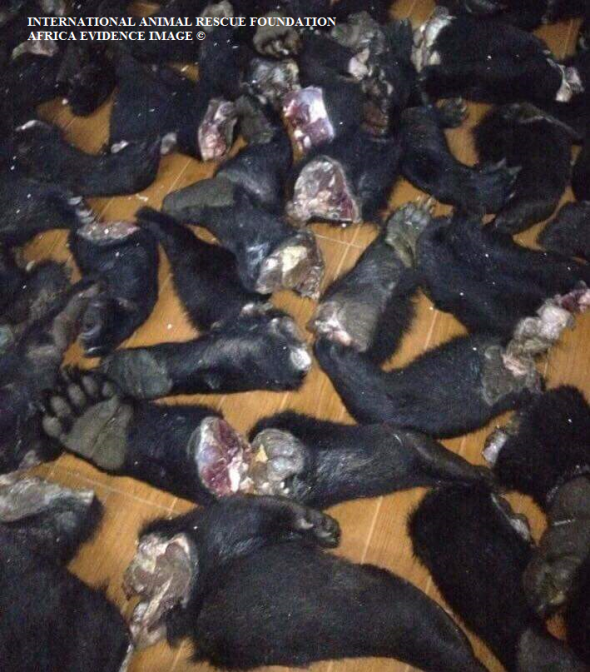
Thai and Vietnam traders offered investigators bear paw, that is used to create a fake medicine soup.
The following images below are from tigers that our International Animal Rescue Foundation Asian unit have successfully identified as Sumatran tigers listed as critically endangered on the IUCN - International Union for the Conservation of Nature’s Red List.
Please note you may find some of the images below disturbing and emotionally upsetting.
Investigative officers were told that tigers are bred within small enclosures within the family home. From there the young cubs are then killed with the adults soon after. There body parts are either stored in a freezer whole, or decapitated. On mentioning tiger skins the EAD officers were informed that some of the tigers are skinned of which their pelts can fetch anything in the region of $5,000 to $10,000 USD. Needless to say we were mortified and shocked at the traders openness and complete disregard to the fact tigers are nearing extinction within the wild.
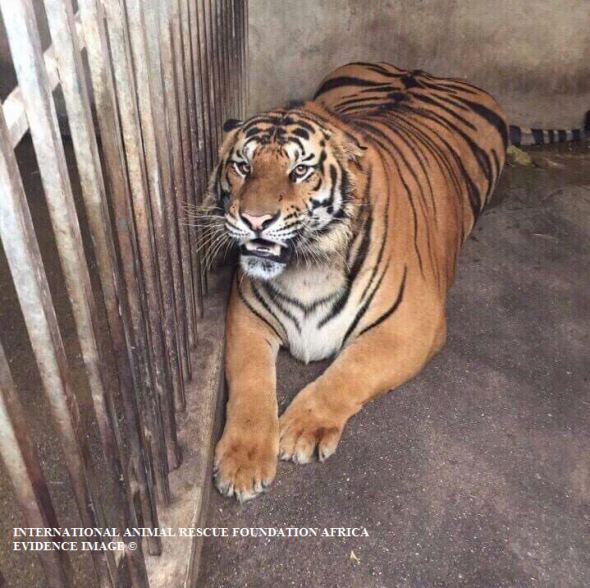
One of nine tigers that both the Thai and Vietnamese traders keep as pets. Sadly to later breed and kill for parts.
The tiger pictured above was being kept as a pet in a dark barred cage in Thailand, Bangkok. We personally believe that the three traders we’ve been monitoring since June 2015 have traded more than nine tigers (if not more). Based on the number of tiger teeth and claws we’ve estimated a probable 20-30 tigers have unfortunately met a rather gruesome and barbaric death, the sheer number of skulls, pelts, teeth, claws and tiger male testicles shows these traders are more than professional. The following images below may be upsetting to some viewers.
Despite the best attempts of law enforcement around the globe, CITES and national NGO’s pushing for stronger laws internationally and locally very little in demand and trade is being seen relating to tigers. A six month investigation of illicit wildlife trade has shown to us that trade is becoming more widespread, younger people are more involved rather than the elder generation. Regardless of education and awareness in schools the E.A.D are now picking up on average a total of 3-4 teenage dealers weekly. Many of them have ties to African bush meat traders too.
As previously explained Asiatic pangolins are nearing extinction, yet despite the amount of seizures being made, little in the way of a decrease in trade is being witnessed. Furthermore as Asian pangolin populations decreases, African pangolins will be poached to continue the trade and demand of pangolin meat, scales and medicine. None of which has any medicinal value whatsoever.
The images below were what prompted E.A.D investigative officers to then look further afield, taking the team from Thailand and Viet Nam to Africa.
From 2010 the External Affairs Department have noticed a staggering increase of tiger teeth and claws on sale via the Social Media platform identified as Facebook. There are two different types of trade. 1. Counterfeit trade which is primarily wooden carved tiger teeth and claws and 2. Real tiger teeth and claws. Like all of the evidence above and below obtained by the EAD’s Operation Trojan Horse officers, every part of the tiger is used for illegal trade.
Tiger teeth and claw necklaces are worn in Asia in the belief that such animal parts will bring the wearer power, good-luck, and ferocity. Many of the traders that we investigate often tell us that they have either found tiger teeth and claws on the ground in forests, purchased antique tiger teeth and claws from dealers. Or in this case have illegally harvested the tiger teeth and claws from home-captive bred tigers seen in the images below. The images below form part of the evidence files on the three individuals spanning from Thailand to Viet Nam.
(Please be warned the following images may be upsetting to some viewers).
Below are step by step guides that the Vietnamese trader bragged to E.A.D officers on how to harvest tiger teeth and claws. The images are upsetting and also include the skinning of tigers.
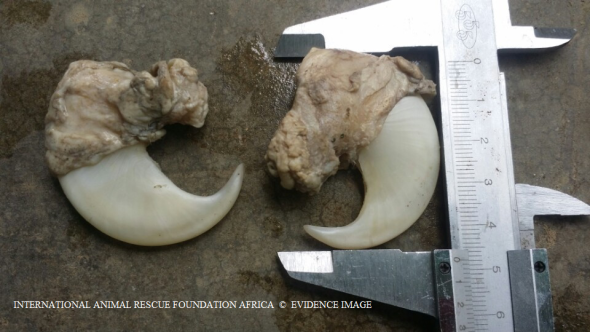
Tiger claws are measured like rhino horn and ivory. This process helps traders to price up and show legitimacy to buyers.
E.A.D officers are (as explained) unsure on the exact number of tigers that these individuals in question are breeding and trading within the home and other premises. From the evidence obtained the number of teeth and claws points to at least 20-30 tigers bred, killed and processed in Thailand and Viet Nam. An unidentified trader who’s name we cannot make public proudly shows on their Facebook page how easy it is to skin a tiger (images seen below).
Tiger testicles are also used within the Traditional Chinese Medicine trade, however this is the first time we ourselves have actually come across such tiger testicle trade (normally one views tiger penis on sale real and counterfeit). The trader[s] we’ve been investigating boasted within an online forum how tiger testicles are now more popular than tiger penis itself.
The image below shows the trader boasting how large the male tiger testicles are before he then sets about to remove, bag and weigh up the testicles for sale. Its believed the testicles ‘may’ be transported illegally into China or onto wealthy Viet Nam/Chinese restaurants where the soup of tiger testicles is ‘allegedly’ known as a delicacy and (aphrodisiac soup). None of which holds any medicinal evidence whatsoever.
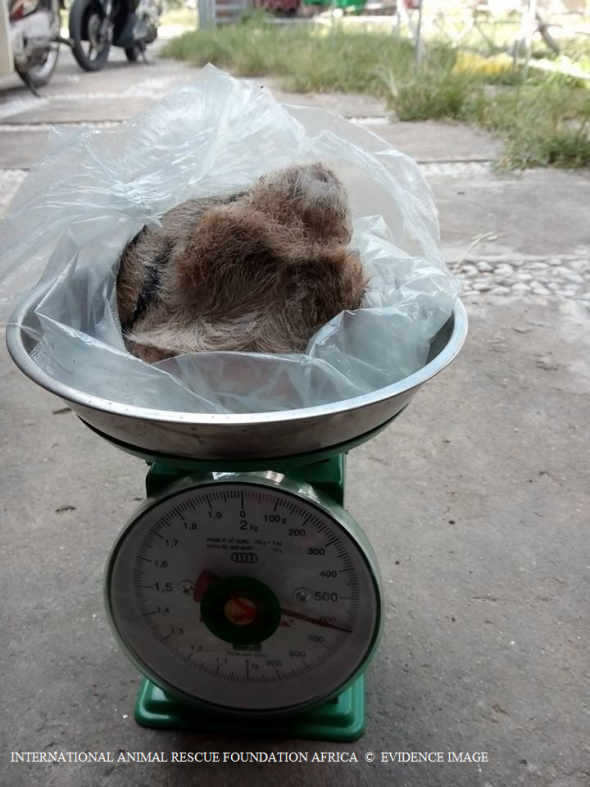
Tiger (testicles) weighed for sale. The testicles will most likely be used to produce tiger testicle soup.
Back in 2013 the Humane Society of the United States stated a total of twenty seven countries had outlawed the sale and trade of shark-fin for the production of shark-fin soup. One would then be led to believe that since this mass outlawing and bans on trade, it would therefore heavily restrict shark poaching and trade of shark-fin soup. In Thailand and Viet Nam it appears not to be the case (both countries have no bans in place).
Unfortunately when E.A.D officers investigated the traders herein this article, we uncovered more than enough shark-fin trade to prove that neither laws or outlawing of the trade is having any real effect on stopping or restricting the trade of shark-fin. On speaking to the unnamed trader within a forum online for TCM trade, the individual boasted how easy it was to obtain shark fin, an transport that into Asian and North American countries. The images below show shark-fins drying at the traders apartment in Thailand and Vietnam.
International Animal Rescue Foundation Africa and two investigation units aligned with us; External Affairs Unit and Operation Trojan Horse (Cyber Crimes Division) have been tracking countless illegal wildlife traders all over the world since IARFA established the (Cyber Crimes Unit). While the evidence above may shock many, its little compared to what we locate every month. Investigative officers work under immense pressure, stress and must work fast to ensure that traders once located are reported to the relevant agencies.
On the 23rd December 2015 Interpol’s Environmental Crime Unit and the Cyber Crimes Serious Investigation Team were alerted to our findings, while we can state now that our investigation which we have decided to make public has shown much data on trade. The investigation is considered normal due to the size. The most shocking aspect of this investigation was the fact that our younger generation are more active now within this illicit trade. That in itself poses some rather large problems and concerns, and one that now needs addressing at both government and educational level.
As of today 29th December 2015 this investigation has since been increased to “extremely urgent”, and the need to locate these men and women is critical before any further animals die, in Asia and Africa. All three individuals have shown a complete disregard to the fact rhino’s, elephants and tiger populations are losing ground throughout the Asian and African continent. Sharks and pangolins are also nearing extinction too. Trade and demand as explained has skyrocketed online to worrying levels, yet slowly vanishing on the ground.
Thailand is the new hub for rhino horn trade and Facebook and other social media platforms are being exploited to trade just about anything wildlife, regardless of such products being illegal. Trade and demand on the ground has also changed from elder to younger individuals (as explained) which is very worrying. One of the largest trading countries that we are seeing to date, is that of Thailand, which would explain why the BBC back in 2014 couldn’t locate much in the way of rhino horn (in Viet Nam).
Since General Prayut Chan-o-cha took over running of Thailand back in 2014 wildlife trade has skyrocketed. While we cannot prove increasing trade has anything to do with General Prayut Chan-o-cha, it just seems too coincidental that a sudden spike of rhino horn, ivory and other wildlife products has shot through the roof.
Facebook was where this investigation ended prompting us to then send all evidence to Interpol. Facebook hosts some 1.32 billion users worldwide, 32% of which use cell phones to login into the United States platform, thus making it difficult to locate traders and dealers.
International Animal Rescue Foundation Africa have been lobbying Facebook since the start of the year, to implement new terms and conditions to heavily disrupt this trade and demand. A petition that has amassed over five thousand signatures can be signed here and shared. However we’re not holding our breath. Should the Facebook platform and its CEO Mark Zukerburger not implement new polices on trade and demand of illicit wildlife products we will unfortunately soon see many species of animals pushed into extinction. Ivory and rhino horn trade has exploded to worrying new levels. Rhinos, elephants and tigers are being poached moreover, and the internet as well as ground trade is awash with anything from drugs, firearms, child trafficking (most of which links back to illegal wildlife trade).
One of the men that is pictured above is responsible for the trade of wildlife parts above, he has since been reported to Interpol along with his partner and other associates whom we have been investigating since June-December 2015. The individual above is believed to be in Hanoi (Nguyen), or Ho Chi Minh City, possibly with an accomplice. His name and other accomplices we cannot make public as yet. The image is recent.
A more closer image of the individual and the female is located below. We believe based on evidence obtained that the male is using the females account on Facebook too.
May this be a stark warning to all wildlife traders out-there. International Animal Rescue Foundation, External Affairs and Operation Trojan Horse will eventually catch up with you. If we catch you trading in wildlife products we will monitor you on the ground and online. From there we will press for your arrest and detention.
Within the past year Interpol has been escalating their new project identified as OPERATION WORTHY II Operation Worthy is targeting many individuals involved in international and local serious crime.
Updates on this case will follow as and when we’re updated. Thank you for reading.
Chief Environmental Officer (CEO)
Director
If you would like to make a small donation to our organisations investigations department please click the link >here< Your donation funds 10% of our environmental projects, while we ‘self fund’ the remainder 90%. Please contact us via the email above for further information. You are not at liberty to donate, nor do we beg.
“REPORT WILDLIFE CRIME TODAY”
Facebook: Hotbed for Lucrative Ivory and Animal Sales.
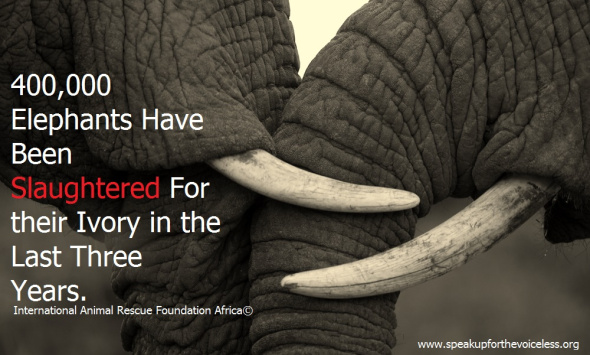
Since 2012 the External Affairs Investigations Unit (EAU), and International Animal Rescue Foundation (IARF), have unearthed a shocking trend of wildlife parts and tropical pet traders on the United States server platform of Facebook.
Operation Trojan Horse has been heading the ground-and-online hunt for traders then shutting them down via intelligence reports passed to the Police, Border Agencies and Internet Service Providers. The Intelligence gathering team state that Facebook is the new wildlife trading site whose technology conceals anything from pornography, murder, child abuse and in this case wildlife parts trade and the tropical pet trade.
Over the past several years we’ve seen a slow decline of wildlife-parts-traders and pet dealers as enforcement tightens around traders and smugglers bringing them to justice. Unfortunately, since as early as 2010 online trade has skyrocketed to new and worrying proportions. Traders intentionally use a textbook of keywords that fool Facebook’s bots and online surveillance teams, according to the External Affairs Unit [comprised of experts from ex-law enforcement officers, intelligence officers and computer experts.]
Investigative officer Tayah, who fronts the main online intelligence gathering team stated: “Firstly I begin by downloading a Virtual Private Network using pseudo details so that my location on G mail or Facebook cannot be traced. Then I have two options after signing up, creating a Facebook group or page. If say I wanted to create a group, I’d title the group using certain keywords to avoid Facebook’s bots and intelligence monitoring teams locating my network. From there I simply add trusted contacts and trade is on in under ten minutes. If I wanted to create a page, I’d again use set keywords and ensure that every country as possible remains banned from viewing the page. I then add say 50+ admins. Job done”.
Tayah makes it sound so easy but exposes a flaw: “Pages that use ‘country banning restrictions’ can still be located in the Facebook search bar. One just changes their Virtual Private Network (GPS) and you can locate anything from illegal porn, animal abuse, wildlife trading, pedophile rings down to dog fighting pages too”. Tayah went onto state: “Unless the user or anyone of the admins unpublished the Facebook page, intelligence gathering is then restricted to Facebook only. If Facebook administrators are unaware of these keywords or technology or are just lacking people power within the law-enforcement department then these ruthless traders will get away with anything”.
Working in conjunction with their Asian counterparts, IARF noticed most traders were deliberately concealing their video and image GPS as well. The problems don’t just end their either. Out of the 1.32 billion Facebook users, a staggering 32 per cent of users log in using a mobile device. One can turn the GPS off on a mobile device and download a Virtual Private Network. For all you know the friend your speaking to on Facebook that’s GPS states there from California in the United States, is really your best friend, wife, husband living with you or near you. That’s how lax Facebook’s online security is.
Tayah goes on to say “The fact I can access pages on Facebook using VPN software clearly shows Facebook is not as secure as it presents itself to be. While Facebook may have protected its millions of citizens, its allowed ruthless and very dangerous criminals to use the platform as a safe haven to buy, sell and trade in illegal animal parts, as well as children, which I’ve witnessed countless times from Russia to Karachi.”
A recent undercover survey uncovered traders selling Slow Loris within Thailand. Slow Loris are protected under Thai law and Cites law (see image below). Please click on all images to be taken to the real time evidence online. We’ve since filed the relevant reports for all and no longer require these images within our file. 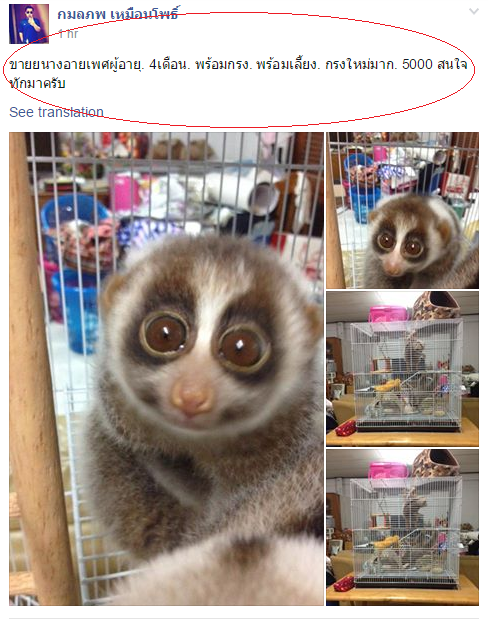
Image: ‘protected’ Slow Loris for sale on Facebook within a tropical pet group.
The trader (pictured above), is not bothered that the Slow Loris is protected under Thailand law. One species out of the five is listed as critically endangered while the remaining four remain listed as vulnerable. The tropical pet trade has been blamed on all five of the species gradually dwindling. Furthermore, Slow Loris despise being handled, brushed or kept as pets.
Slow Loris show a kind of not-bothered-look when being handled by humans. Unfortunately they cannot scream, like we do when tickled, brushed or bathed. Slow Loris hate being handled and do not make good pets. They are solitary creatures and also hate bright light. Yet Facebook has countless numbers of protected Slow Loris for sale, which is absurd, immoral and a slap in the face to conservationists and law enforcement. Is Facebook now above the law?
Facebook must be held accountable for this trade by implementing a ‘strict no wildlife or animal parts trade’ from species that are threatened within their terms and conditions. Should the United States platform not take the relevant actions then we may as well hang up our boots and go home. Frankly we’ve had enough of being ignored and fobbed off.
Endangered Tortoises can be located in many ‘Thai tropical pet and ivory’ trading Facebook forums. The image below depicts a Yellow Foot Tortoise, a species of reptile that isn’t endemic from the region of Thailand. Identified back in 1766 by Professor Carl von Linnaeus, the species is known as Chelonoidis denticulata classified as Vulnerable.
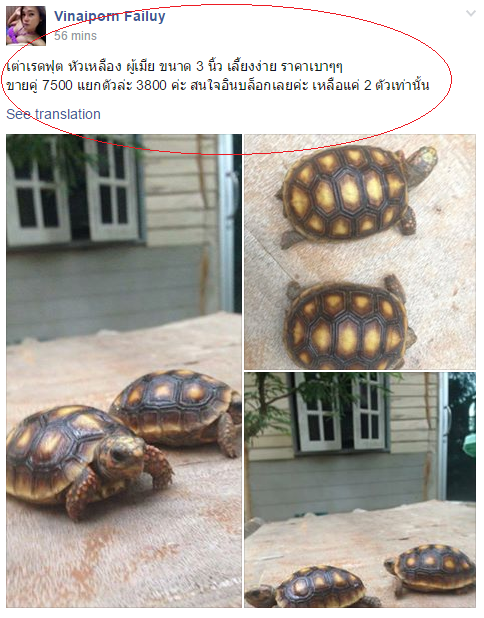
Image: Yellow Foot Tortoise are listed as vulnerable; Pet trade threatens their future.
Although not considered illegal to breed the species, EAU officers from Malaysia were mortified to know the breeder is importing the vulnerable species from South America. The unnamed breeder [not shown above], whom we cannot name, would not divulge how the tortoises are brought into the country but made it clear he could easily obtain more infants on demand, over the border from the wild.
Chelonoidis denticulata is an endangered species. The major populations located in South America are protected under the Convention on International Trade in Endangered Species, Appendix II. As with many species of Turtles and Tortoises, many Brazilian giant Tortoises end up as food items in local markets. This species of Tortoise is popular in the pet trade.
Despite the numerous specimens of endangered and nearing extinct tropical pets for sale on Facebook, one major concern is the illicit ivory trade. Back in 2013 IARF-Asia conducted a random survey within Thailand, aimed at active Facebook members of the public, both female and male from the ages of 16-21. 85% of respondents stated that they would not purchase, deal or trade in ivory and knew where ivory came from. The remaining 15% stated that they had traded, were trading or knew of relatives trading ivory and Rhinoceros horn.
We were skeptical to begin with because according to many third party reports, most whole tusks, or jewelry ivory sales appeared to be traded by adults rather than minors and teenagers. Researching Facebook from 2013 we not only discovered that Facebook was a hotbed for ivory sales - but the teenagers and minors whom IARF-Asia had questioned within Thailand were actively trading ivory online using Facebook. One trader, circled in red within the image below, brags he is trading ‘carved ivory’ within his shop, which later turned out to be his uncles shop (2013.)
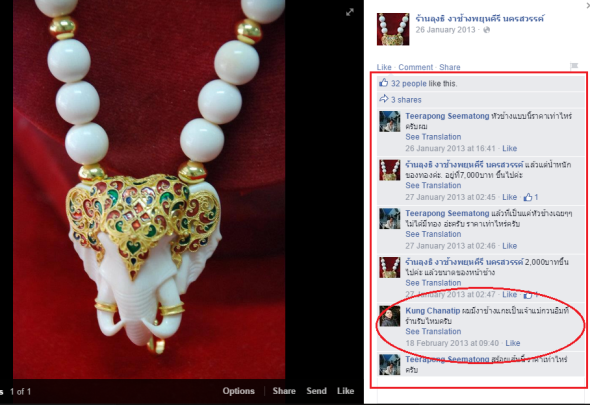
Image: Ivory traders on Facebook 2013
Since re-examining the vast majority of respondents that originally stated they were not dealing with ivory, Facebook seems to have become a hotbed for ivory sales for figurines, pendents, amulets, down to large freshly carved tusks. IARF-Asia also noticed that since Thailand’s new leader, Prayuth Chan-ocha took over the country, ivory trade has increased to shocking levels.
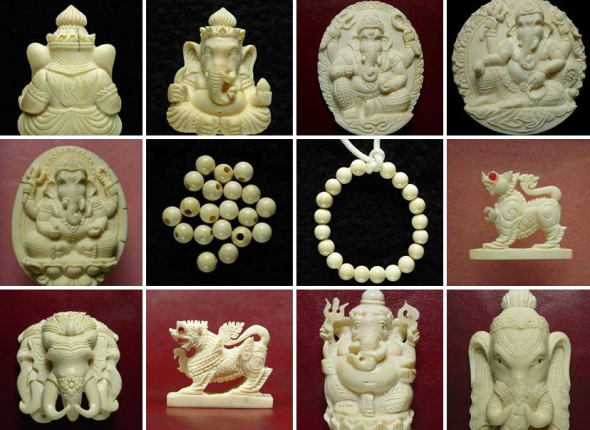
Image: Ivory Facebook profile set up as an online trade shop
Most traders will open up a Facebook account using words such as ‘ivory, ivory carvings, ivory trade, authentic ivory,’ etc. They will post photographs of some of their best selling items and then leave the page, group or their profile open for the public to view. Although the account may appear inactive, the trader silently monitors his account very closely because these profiles are created as mini shops for customers to purchase ivory pendents, charms, bracelets or carved tusks.
We are not only pointing our finger at Thailand or Facebook alone, despite Facebook seemingly unaware these traders are selling freshly carved and re-worked ivory illegally. Click on the image below and you’ll be taken through a Facebook group that is selling anything from Tiger bone wine, Bear claws and of course - ivory, in Viet Nam - on the United States social media platform.

Image: Viet Nam wildlife trading group on Facebook.
Not only insulting Africa’s heritage, but as a smack in the face to conservationists and a punch in the eye to law enforcement, one trader poses with an ivory carved Rhinoceros statue (pictured below.) Facebook is considered to be one of the largest hubs for illegal animal-parts trades that the EAU has located in years. Between 2012 -2105, IARF’s enforcement teams located multiple thousands of illegal traders openly and illegally flaunting Rhino horn and ivory.

Image: Rhinoceros figurine carved from poached ivory for sale on Facebook.
Shocked and in disbelief at the new findings by IARF’s intelligence teams, we wonder where have we gone wrong. Back in 2013-2014 a massive online enforcement campaign took place bringing down sites trading in animal parts, while Internet Service Providers (ISP) and online buy and sell sites took the pledge to not allow such items on sale. Unfortunately this has pushed many into the secretive and ‘secure’ platform of Facebook.
While there is continued demand and sale for illegal wildlife and animal parts, somewhere on the African or Asian continent an Elephant will be in the cross hairs of a poacher. The illegally poached animal’s body parts will be trafficked from Africa to Asia, then from user to Facebook, to meet the ever increasing demand that is sadly taking the social media platform by storm.
Within the past three years the Convention on International Trade of Endangered Species (CITES), stated some 400,000 Elephants had been slaughtered on the African continent alone.
There have been numerous large seizures of ivory and convictions of persons involved. Some countries are burning stockpiles of ivory to send a clear message to poachers and traders but despite these actions, the ivory trade continues. China announced in June of last year that enforcement teams had seized a total of 270 kilograms of ivory and Rhinoceros horn. Yet despite such seizures the trade goes on in the face of the law and as Facebook seems non-to-bothered some of the 1.32 billion users are using the platform as a trade and sell site laughing in the face of enforcement and conservationists.
In another shocking Facebook find, a routine search of Japanese traders revealed peddlers openly selling African Elephant ivory online. The shop (listed below), is set up as a hobby shop which works old and new ivory, creating pendents and necklaces, etc. The Japanese shop’s ivory belongs to Elephants which were illegally slaughtered on the continent of Africa, along with some re-carved antique specimens, which therefore continues demand and the illegal poaching. Please click on the image below, which will direct you to the Japanese Facebook page.
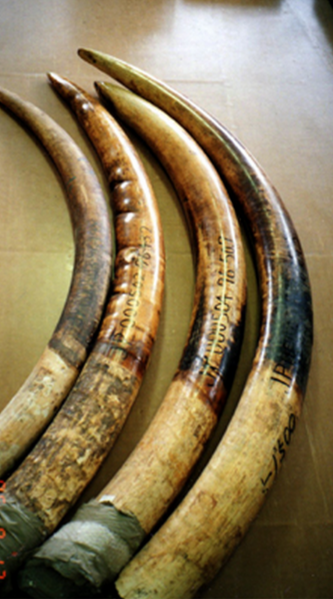 Image: African Elephant Ivory.
Image: African Elephant Ivory.
In April this year, Excellency Shinzo Abi was encouraged by major animal welfare organizations to cease trade in ivory and destroy any stockpiles being held in Japan. Since 1970, Japan has imported ivory from more than 250,000 African elephants, mainly from tusks that were illegally acquired through poaching wild elephants.
Japan has been granted permission twice to buy ivory, despite the UN Convention on International Trade in Endangered Species of Wild Fauna and Flora (CITES) 1989 ban on international commercial trade in African elephant ivory, which was adopted in response to the global elephant poaching crisis of the 1970s-80s.
In 1997, Japan secured CITES-approved ivory sales for nearly 50 tonnes of ivory from Zimbabwe, Botswana, and Namibia. In 2008, Japan was allowed to import a further 48 tonnes of ivory. Japan agreed to implement a domestic ivory control system that would prevent the laundering of illicit ivory, as a condition of both sales. This system has not worked, instead it has increased international demand for ivory and driven up poaching rates.
Of particular concern is the ivory “registration” program which can be used to grant legal status to illegal tusks or tusks of dubious legality. In the last four years alone, the Government of Japan has “registered” 5,600 tusks weighing more than 50 tonnes, bringing the total registered since 1995 to over 14,000 tusks, comprising 185 tonnes of ivory.
The “registration” of ivory tusks is a massive loophole that can be used to launder illegal ivory onto the Japanese market.
Read more here
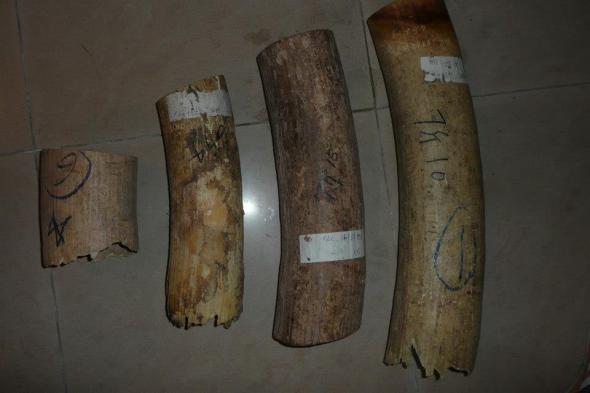
Image: Japanese Ivory trader selling freely on Facebook.
The image below was posted among other groups from a man known as Mr Houng (power), who appears to communicate with a woman known as Miss Grace Chung, who we believe is from Osarka, Japan and runs various ivory carving shops (please click the image below to view groups). While the EAU team cannot provide any real data on these two individuals, they appear to be financially well off and have no problems at locating ivory. Miss Chung has three to four Facebook groups and various pages linked to Chinese ivory trading shops. Miss Chung is directly related to the Japanese ivory dealer and ‘alleged’ hobbyist above.
Mr Houng is seen communicating to Miss Chung within her alleged ‘ivory stone and wood workshop.’ The woman states “that’s a lot,” while other Facebook users display their ivory through images, throughout this group and a further group (which we have accessed but cannot disclose at this time.) All the ivory within the image below derives from 99% non-permitted ivory, meaning its illegal and has no permits whatsoever as investigated by the EIA.
The left hand image’s GPS is from China. We’ve checked various sources in relation to the right hand image and sadly there is not a trace that we can find. Based on Mr Houng’s monetary status, it is quite possible he knows exactly whom this ivory belongs too as he posted the photograph, which seems untraceable on all five of the top search engines. It would be wrong to accuse Miss Chung of any wrongdoing in relation to either image, however the image above derives from a Japanese Facebook ivory workshop which posts images of significantly high volumes of cut off ivory pieces.

Image: close to two tons of African Elephant ivory.
Some Facebook groups and pages also contain walrus ivory which isn’t illegal if the animal died naturally or you legally hunted the animal. The problem surrounding walrus ivory is that some traders of elephant ivory use walrus ivory as a smokescreen to sell elephant ivory online. Unless you are an ivory expert, it is difficult to distinguish the difference between elephant ivory and walrus ivory. Elephant ivory traders do their best to conceal their trade by either stating their part of a walrus ivory group and/or trade Elephant ivory into, or against walrus ivory, furthermore some online ivory dealers trade under the name of ‘ox-bone’. Only ivory experts can tell the difference. Can you tell the difference from the images above to the images below without Googling?
Image: walrus tusks
Even some of the best experts can at times fall prey to the walrus ivory trade - however there is a difference. Walrus tusk ivory comes from two modified upper canines and is known as a material, as morse. The tusks of a Pacific walrus may attain a length of one meter. Walrus teeth are also commercially carved and traded. The average walrus tooth has a rounded, irregular peg shape and is approximately 5 cm in length. Lets see whom can tell the difference or if there is a difference.
Poaching of protected or managed species, trafficking and the illegal trade in wildlife and their related parts and products has escalated into an international crisis in the last decade! Wildlife trafficking is both a critical conservation concern and a threat to global security, with significant effects on the national interest of the United States and the interests of our partners around the world. For every piece of ivory that is purchased the money from that ivory then makes its way back to terrorists.
Using money from illegal trade in wildlife and related parts and products, terrorists such as Al Shabab then commit atrocities such as filmed within the video below. These atrocities are funded exclusively by each person who purchases ivory. The more ivory bought and sold, the more it empowers terrorist activity.
The video included below provides a non-graphic but powerful account of how ivory sales and trade funds terrorism. Please do view the video and take into account all those innocent civilians that could be with us today. Sadly they’re not all due to ivory funded terrorism.
The current number of remaining African Elephants is not known, due to their large migratory behavior. We do know that in Central Africa all Elephant ‘populations’ are endangered. In Eastern Africa Elephant populations are listed as vulnerable. South African Elephant populations are listed as least-concern and finally, in Western Africa Elephant populations are listed as vulnerable. Please refer to the table contents below, lifted from the last revised summery.
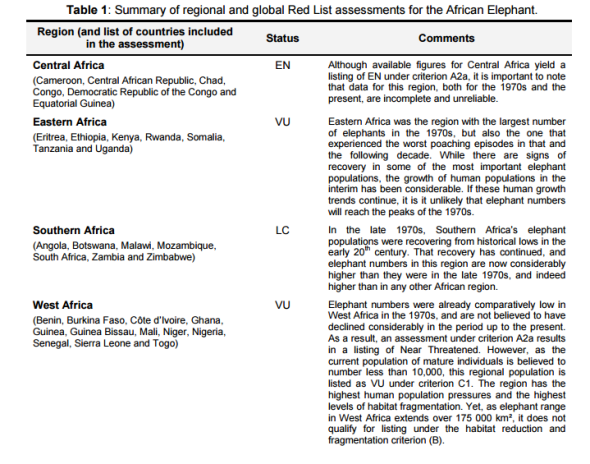 Image: table of assessments for the African Elephant
Image: table of assessments for the African Elephant
Whilst overlooking Viet Nam, CITES issued Thailand a direct warning in May, to quit the illegal ivory trade or CITES would impose immediate trade sanctions against the country. Why not Viet Nam, Japan or China?
Thailand ‘had’ until the end of March 2015 to take measures to shut down domestic trade in illegal elephant ivory or it will face trade sanctions under the Convention on the International Trade of Endangered Species (CITES), which met in Geneva last July. It must enact legislation to stem the trade of illegal African ivory in the country and implement a registration system for domestic ivory and ivory traders.
“WWF welcomes this decision and applauds the key role of the US delegation in holding Thailand accountable for their lack of progress since 2013 when it pledged to shut down its ivory market,” said Leigh Henry, WWF’s Senior Policy Advisor at the meeting. “Elephants across Africa and Asia are being slaughtered for ivory and illegal markets in countries like Thailand are allowing wildlife crime to flourish.”
Possible sanctions would impact Thailand’s trade in species covered by the convention, including ornamental plants, such as orchids, and reptile leather. Trade suspensions would, for example, prevent exports of orchids, which would result in a loss of more than $80.7 million in annual sales based on the 2013 value of this trade. The economic impact would be significant as the value of just some of Thailand’s CITES-listed export items was estimated at $157 million in 2012.
So we’ll now await for Cites response and if any trade sanctions will be imposed, IARF will also be calling on the same trade sanctions to be imposed on China, Japan and Viet Nam. After all the evidence is above for all and sundry to view - and this is just a mere 1% of evidence we hold on file of past and present illegal ivory trade.
Meanwhile a staggering ‘estimated’ one hundred Elephants are being slaughtered daily on the continent of Africa with some ten to fifteen killed a week in Asia. We plead with all our supporters 5.4 million of you, to demand Facebook now cleanses their server of all illegal ivory traders, shops, groups and individual buyers. We must continue to disrupt the trade, failing this we’ll never tackle the demand problem, and sadly Elephants will soon become nothing but a story or artifact within a dusty museum.
Thank you for reading.
I thank all members of the External Affairs Unit, International Animal Rescue Foundation Asia and the current operation leaders that have been fronting the online task force since 2010 known as #OperationTrojanHorse..
Dr Jose C. Depre
Chief Environmental Officer
Chief Executive Officer
Animal Rights in Asia - Meet Vivian
As an influencial Japanese activist and demonstrator, Vivian and her fellow friends have demonstrated outstanding commitment and compassion to many abusive animal regimes. Those who believe all Asians are cruel and barbaric to animals should read this touching interview that we hope will open the eyes of many.
Animal and environmental abuse can provoke great anger and emotion worldwide, which can cause many people to lose control and voice more than their basic opinions or thoughts. Racist comments and death threats has made us concerned that the animal and environmental community is being blackened by such derogatory and abusive comments.
Since the beginning of 2011 the International Animal Rescue Foundation.Org and Speak Up For the Voiceless.Org have noticed many derogatory and racial comments on our more controversial posts featuring topics such as the dog and cat meat trade, dolphin and whale slaughter and the fur trade. There seems to be more hatred directed at the entire population of Asia than that of the individual abuser, user or producer featured in the stories.
We do not support hateful, racist or derogatory comments, whether it be toward abusers or the countries as a whole. Should such comments not cease immediately we will no longer post such stories and investigations, which will only decrease awareness and monetary funding to those causes within Asia that require important, daily funding for an array of animal and environmental issues and projects.Racism and hatred toward any community or country will no longer be tolerated!
For example: “I wish an atom bomb would drop onto Asia; Asian chinks should all be slaughtered; burn all Asians,” to the most upsetting: “all Asian children should be burned at birth,” are just a few of the most disgusting and revolting comments that have appeared on our posts. Why blame the entire community for animal and environmental abuse committed by a minority of people? Furthermore, why throw racial comments at an abuser? These issues have nothing to do with race – it is animal abuse that we must all focus on, not hatred toward an entire race or culture.
This month we focus on Animal Rights within Japan. A country known for its abuse of whales in the Australian-owned Arctic territory, the illegal animal parts trade and the fur trade, it is also andmost importantly known for its animal rights activism a movement that is now taking Japan by storm. On the 12th of December 2013 we conducted a brief interview via email with one of Japan’s most influential animal rights activists.
Meet Vivian, who has been working to eradicate animal abuse and highlight these atrocities despite governmental suppression and public hatred. Vivian is one of many activists who we admire who shows courage and determination, especially for one of such a young age. Harvey Allmendinger, our Environmental Protection Team Leader, had a chance to interviewe Vivian, an interview that paints a more positive light on the positive treatment of animals within Asia, a reality that many people around the world fail to recognise.
Animal Rights Japan – What the World Needs to Know
Harvey – Vivian, how would you best describe yourself as an Asian activist for the voiceless?
Vivian – I am an activist who raises animal rights activists and leads them to Veganism / Vegetarianism by providing a lot of important information and creating awareness.
Harvey – Vivian, what inspired you to become a voice for the many thousands of innocent animals within Japan and how long have you been demonstrating?
Vivian – I have loved animals since my childhood and have always wanted to do something for animals. In 2007, I saw a documentary TV show featuring a woman who manages a shelter to protect animals that are abused or poached by people in Colombia. The abuse against those animals was terrible and hard to believe.. It made me sick and I cried for about a week, unable to contain myself. I thought that I must go to the shelter in Colombia, but I didn’t know how to get there. I looked for the information on the Internet and found that there is lots of animal abuse in our everyday life, and in Japan too, such as animal testing and the fur and skin trade. Animals exist as economical objects for humanuse . After discovering that I become a member of NPO JAVA (Japan Anti-Vivisection Association) in Japan, and started my activism for animals in earnest around 2009, so it’s been about for four years.
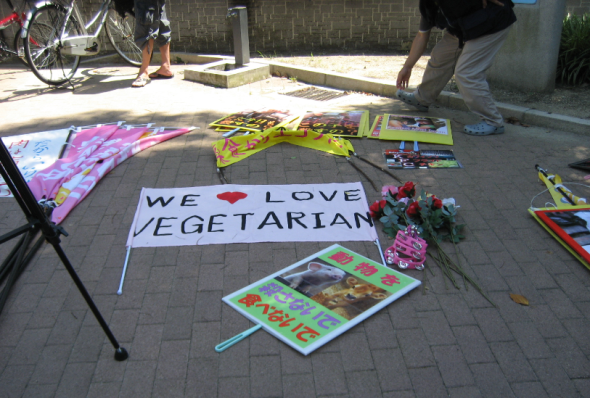
Harvey – Where have you been the most successful as an animal activist, for example, have you managed to change laws, have you changed the way a dog breeding farm works or have you stopped abuse in some other way?
Vivian – With Shiseido, the largest cosmetic company in Japan, which has stopped their Animal Testing (except for in China). JAVA started a negative boycott campaign to stop Shiseido’s Animal Testing in 2009. We conducted demonstration marches in front of Shiseido stockholder meetings in Tokyo and Osaka and asked stockholders to pressure the company to stop animal testing. JAVA also collected signatures through the Internet and a newspaper advertisement, and then handed over about 46,000 signatures to Shiseido. These activities were featured by the media , which attracted people’s attention the fact that animal cosmetic testing is a social problem in Japan. In March 2010, fter about a year after starting the campaign, Shiseido announced that they would begin an effort to abolish animal testing, and in Feb. 2013 they officially announced they would abolish animal testing for all their cosmetics (including materials and commissioning manufacturer) which they began two months later (except for China).
This was a huge victory for animals and for us. Many people’s voices moved the big mountain, Shiseido, and it proved that our movement and our activities were able to bear fruit.
Harvey – Vivian, what you and JAVA have accomplished is amazing and we thank you for so much for your dedication and hard work. People like you and those at JAVA show the world that the Asian community does care about animals.
So what has been your largest demonstration, why did you demonstrate and did it make a difference? I am asking why because it shows the animal welfare community outside of Japan how capable and passionate Asian activists are about making change.
Vivian – Our first demonstration against eating meat in Japan took place on July 18th, 2010 Sunday. This was the first demonstration against eating meat in Japan, and it played an important role in raising the awareness of the Japanese people.

Harvey – What are your thoughts about the fur and meat trade of dogs and cats?
Vivian – I am absolutely against the fur and meat trade of dogs and cats. Japanese people love dogs and cats, and most don’t know that dogs and cats are killed for fur and meat. I want them to know the truth. I think if the Japanese people knew the truth, they would be shocked and it would be an opportunity to think about those issues and stop them .
Harvey – Whenever Speak Up For the Voiceless.Org and many other animal and environmental organisations create awareness about the dog and cat meat and fur trade within Asia we receive such harsh racial slurs against Asians. The general public does not understand that those who do the abusing are only a minority and instead, they blame all Asian citizens. What are your thoughts on this and do you have a message to those people that brand all Asians as cruel to animals?
Vivian – I think the culture that eats dog and cat meat, as well as dolphin and whale, has to be criticized. However, in Asian countries, I guess many people think the culture is is comprised of elderly people and out of date - many don’t even know about the culture. I think if more people knew the facts they would see that this culture is wrong and not humane. I want those people who think all Asian people are cruel to know these things and that many people within Asia are also upset about this cruelty .
Harvey – When we document the cruel abuse that animals suffer within Asia we are met with comments such as, “boycott Asian products.” What are your thoughts about this and do you think it is fair for people to ask for this knowing that boycotts affect innocent Asian citizens and can potentially harm them economically?
Vivian – When we want to solve these problems, we have to consider doing more effective, productive and meaningful things and organize a plan. Products are produced because the consumer wants to buy them. I think if the consumer stops buying products made in countries that abuse animals or made from abused animals, the products will not be produced, so that can be effective, however, to boycott Asian or some other country’s products indiscriminately is not good or effective.
Harvey – Thank you for explaining that, Vivian. I do believe that if people boycotted products that are made from abused animals then this would be very beneficial . To boycott an entire country is not good or very effective and can have disastrous effects for many, even those who are actively fighting to stop abuse.
I see that you have been working on many issues such as anti-fur, anti-vivisection, no kill / adopting, vegetarian / anti meat-eating, animal welfare. Please describe what your role is with these projects and how influential you have been - have you made change happen, and if so, how did this make you and others feel?
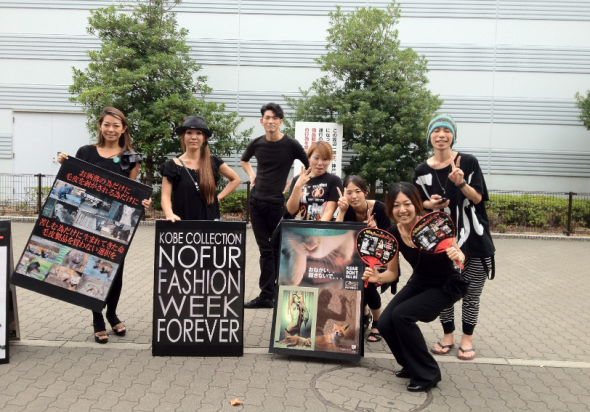
Vivian – I did succeed in spreading awareness through many actions and to many people through demo marches, panel exhibitions, leafleting, SNS, blog, BBS and so on. I’ve also appealed to many companies, administrations and governments etc. to save animals via stopping animal testing, killing dogs and cats, to making effective laws to protect animals and so on via telephone, fax, e-mail and mail, as well as offering information about living a cruel-free lifestyle by becoming vegan/vegetarian, boycotting products that use animal testing and promoting vegan products. One of our most successful actions was Shiseido’s Stop Animal Testing boycott campaign. I think it is most important to spread facts and awareness but also the facts on what and how to do even one little thing to help animals. Over the several years my fellow activists and friends have beenspreading these facts awareness I received so many reactions such as, “I was shocked I became a vegan/vegetarian,” or, “I didn’t know these facts, thank you for telling me,” or, “I will start doing something to help animals, like you,” or, “I want to join in your activities because I want to be voice of animals”. All of these comments encourage me and make me feel glad I have been doing these things . We have to continue widening the circle of awareness.
Harvey – Vivisection is an appalling act of animal abuse. What is your message to the European and American vivisectionists that take animals from Asia to use and barbarically torture?
Vivian – Honestly, I want them to stop every vivisection now since they are meaningless and wrong from the point of view of ethics and science and for people and animals. Also, the transportation of these animals, which places them in very stressful conditions for long periods of time, is unacceptable. Harvey – Your demonstrations in Japan look very effective and colourful Many activists across the globe often have issues with police suppression. . What are your thoughts on this and have you or a friend ever experienced police brutality?
Vivian – In my area most policemen are polite and good to us, as well as cooperative, as we are, so I have never felt bad around them. Some of them have actually praised our activities and our demonstrations .
Harvey – Vivian are you a vegetarian or vegan? What made you turn to (either) and why?
Vivian – I’m a strict vegan because I want to help animals and don’t want to eat them. Many animals will not be produced and killed if I stop eating or using animals. I stopped eating meat and became a vegan once I become aware of animal abuse and understood that many animal rights activists are vegan / vegetarian. I think veganism is a non-violent lifestyle, and to become vegan is just a starting point for me. For animals, environments, people and our earth, we can do many more and very simple things to put a brake on this mass production / consumption / destruction economy. We need to popularize being vegan.
Harvey – The Sea Shepherd Conservation Society have been actively making great progress against the whaling business by lowering kill rates and highlighting abuse. However, SSCS has come under great fire from the Japanese and other governments for its effective non-violent campaign. What is your position on the whaling business, do you believe that Japan must stop whaling to protect future marine conservation sites and mammals and what are your thoughts on the consumption of whale meat and why the Japanese culture should end it?
Vivian – I think Japan must stop whaling now for the conservation of the environment and the animals. Whaling is continued due to our taxes for political concessions and earns copious profits for only few people. There is actually a surplus on many whale meats, whichcauses low demand, so it is unnecessary.
Harvey – The International Animal Rescue Foundation has been actively fighting against the use of rhinoceros horn as pseudo medicine in the traditional Chinese medicine trade. . Rhinoceros in Asia and India are brutally slain for their horns, which are hacked off to feed this repulsive trade in Asia. What are your thoughts on this and do you have a message to say to the Asian and non-Asian Rhino horn medicine-using community?
Vivian – Hunting rhinoceros is so cruel and this abuse should never be accepted - we must stop it soon. Humands need to stop using animals for their own selfish desires.
Harvey – Every 15 minutes an elephant is barbarically killed in Africa just to provide ivory, better known as white gold. We are losing a staggering 35,000+ elephants a year due to the fact that many Asian individuals believe that the elephants tusk can be removed without killing the animal . What are your thoughts on this and have you demonstrated against the use of rhino and ivory parts, as well as the poaching of these two mammals?
Vivian – This is also horrible - hunting rhinoceros and elephant must stop now. A lot of substitutes already exist, so there is no reason to use real ivory. I have signed some petitions and spread these facts throughout the Internet to help stop this abuse.
Harvey – Millions of dogs and cats are left homeless every year internationally and locally within Japan because of animal neglect and abuse. What work have you done to promote a no-kill policy and the adopt, don’t shop philosophy?
Vivian – It’s so shameful that we have not stopped this kind of slaughter in our own country. The number of animals abandoned at (animal shelters) is still big. Most of them are unwanted kittens, so we have also promote sterilization http://ejje.weblio.jp/content/sterilization and castration operations to help control the unwanted cat population. Also, to stop killing animals, we have to abolish the commercial pet industry. I have been involved in many educational actions such as demonstration marches, leafleting, panel exhibitions and Internet awareness spreading as well as posting our demands to stop the needless killing of animals. Additionally, I have visited administrative facilities (animal shelters) that have many animals and kill animals and had meetings with those in charge. The Law of Humane Treatment and Management of Animals of Japan were revised slightly in 2013, but it is not strong enough and has not been used efficiently yet. We have to continue our educational activities, and make many more people understand why they should choose to adopt, not shop.
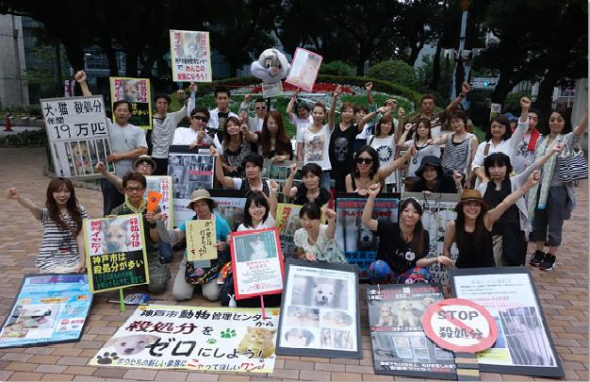
Harvey – That’s amazing, Vivian - your contributions and hard work are breathtaking. You really do show such love and compassion and possess such a strong voice for stray animals within your country and others. Well done!
I would like to take this opportunity in thanking you, Vivian, for answering my questions and to thank your fellow activists at JAVA for such outstanding work and achievements. It really goes to show that the Asian community does care, hates animal abuse and that there are only a minority of people that actually do kill and abuse animals. Knowing that few people within Japan are actually aware of such abusive regimes can only inspire us to promote and support all Asian activists and create more awareness about their works.
“ “My aim is not only to stop animal abuse but also to change our current mass production, consumption, destruction economy,” says Vivian. “I will fight to end the suffering of animals until the end of my life.”
Now who can say that all Asian citizens are animal abusers who will kill anything? International Animal Rescue Foundation and Speak Up For the Voiceless actively supports many Asian activists whose work to reduce animal cruelty and change laws to protect animal welfare we will continue to highlight. Vivian is a young, passionateactivist that has committed her life to animal welfare - we can’t thank her and comrades enough for working so hard to create such positive change for animals in their country .

